Course: BDI Course
CLASS OBJECTIVES
The primary goals of this course are as follows:
- To help participants become responsible drivers by providing them with accurate and current information.
- To help participants realize that proper attitudes will make them safer drivers.
- To remind participants of Florida Law as it pertains to the operation of a motor vehicle.
- To help participants develop respect for obedience of traffic laws as a result of their knowledge of Florida Law.
- To help participants realize that to be good drivers, they must practice courtesy, discipline and patience in their driving behaviors.
Table of Contents
Section 1 Introduction (1 minute 30 seconds)
Section 2 Traffic Crash Problem - Magnitude and Factors (15 minutes 30 seconds)
2.1 Societal and personal losses
2.2 Contribution of DUI and other hazardous acts
Section 3 Crash Dynamics (15 minutes)
3.1 Effect of speed on force of impact
3.2 What happens in a crash and the concept of the 1st, 2nd and 3rd collision
3.3 Energy absorption in relation to vehicle design and direction of impact
Section 4 Crash Prevention Techniques (65 minutes, including a 10 minute break)
4.1 SIPDE, including distance guidelines and adaptation to surroundings
4.2 Following distance, including two-second minimum, when to increase speed and dealing with tailgaters
4.3 Stopping distance in relationship to speed
4.4 Environmental hazards, rain, slick roads, standing water, fog and wind
4.5 Vehicle emergencies, tire failure, brake failure and loss of power steering
4.6 Sharing the road with large trucks and vulnerable road users
4.7 Passing laws with information on clear distance and prohibitive situations
4.8 Right of way, including the concept that no driver can claim the right of way and what to do when traffic lights malfunction
4.9 Speed adjustment in relationship to environmental hazards, surroundings, school zones and construction zones
4.10 Wireless communications
4.11 Railroad crossings
Section 5 DUI Prevention (28 minutes 30 seconds)
5.1 Effect of alcohol and other drugs on driver capabilities, including judgment, vision, reaction time and the order in which these effects occur
5.2 Relationship of the amount of alcohol consumed to BAC and the equivalence of different types of alcoholic beverages
5.3 Legal consequences, including the increasing severity with repeated offenses and financial consequences of DUI (personal and societal)
5.4 Ways to avoid driving impaired
Section 6 Safety Equipment (25 minutes)
6.1 Safety belts - Proper positioning, adjustment and drivers' legal responsibilities
6.2 Head rests - Proper positioning and adjustment
6.3 Child restraints - Proper positioning and adjustment and drivers' legal responsibilities
6.4 Airbags including special precautions regarding children and small adults
6.5 Importance of vehicle maintenance
Section 7 Psychological factors (35 minutes 30 seconds, including a 10 minute break)
7.1 Dealing with stress
7.2 Dealing with fatigue
7.3 Dealing with emotional distress
7.4 Appropriate attitude
Section 8 Florida Traffic Laws (55 minutes)
8.1 Progressive severity of legal actions including the point system and licensing actions (cancellation, suspension and revocation)
8.2 Speed limits including default limits where not posted
8.3 Signs, signals, road markings, interpretation of centerlines, crosswalks, bike lines, turn lanes, flashing lights and proper responses to phases of traffic signals, stop signs and yield signs
8.4 School buses including laws on passing while stopped
8.5 Proper response to emergency vehicles
8.6 Required vehicle safety equipment
1. Introduction
Thank you for choosing Lowest Price Traffic School for your Basic Driver Improvement course.
Lowest Price Traffic School has designed this course for use on the internet. Your computer must meet the minimum standards of a Pentium 1, 133 MHz in order to fully capture all of the information. This course meets the requirements of the Department of Highway Safety and Motor Vehicles requirements standard and is approved for use in the State of Florida in accordance with Section 318.1451 of the Florida Statutes and Chapter 15 A-8 of the Florida Administrative Code as a Basic Driver Improvement course.
This course is divided into eight sections with two timed ten-minute breaks. Each section is to be completed sequentially. Seven practice quizzes will be administered during the course from randomly generated questions. The quizzes will be corrected and you will have an opportunity to see which questions you answered correctly and incorrectly. Each section must be completed sequentially. At the end of the four hours a certificate of completion will be mailed to you, provided you have passed a final exam consisting of 40 multiple choice questions. The minimum passing score on the Final Exam is 80%. The exam is open book and you will be allowed to refer to the course work to assist you in answering the questions correctly. If you fail the final exam, you will not be issued a certificate. You will have to retake the final exam and obtain a passing score in order to be issued a certificate.
During the course you will be asked ten random validation questions. The answers must match the answers that are given during the registration process. If you fail to answer the questions correctly, you will be locked out of the course until you speak with a customer service representative.
Please complete the registration and follow all instructions as prompted by this course. Should you not understand any portion of the course you may reach Lowest Price Traffic School at 1-800-729-1997 from Monday to Friday 9:00am to 6:00pm EST.
2. Traffic Crash Problem - Magnitude and Factors
- Societal and personal losses from traffic crashes
- Contribution of DUI and other hazardous acts
2. 1. Societal and personal losses from traffic crashes
Motor vehicle travel is the primary means of transportation in the United States, providing an unprecedented degree of mobility. Yet for all its advantages, deaths and injuries resulting from motor vehicle crashes are the leading cause of death for children ages 10 and 11 and young people 16 to 22 years of age.
In 2016, the fatality rate increased to 1.18 persons killed on the roads for every 100 million miles driven after falling to a historic low of 1.10 in 20111. The 2007 rate was 1.36 per 100 million vehicle miles traveled. In Florida, 89.6% of all drivers avoided injury by using their safety belt, an increase from 89.4% in 2015. Nationwide, seat belt use increased from 88.5% in 2015 to 90.1% in 2016.2 However, much remains to be done. The economic cost nationwide of motor vehicle crashes in 2010 was estimated to be 242 billion dollars. Some of these costs include:
- $76.1 billion - Building and property damage annually.
- $57.6 billion - Lost workplace productivity.
- $52.5 billion - Alcohol impaired driving crashes annually.
- $23.4 billion - Medical costs annually.
- $28 billion - Loss in travel delay.
- $52 billion - Lost due to speeding crashes annually.
- $39.7 billion - Due to distracted driving annually.3
And consider the following statistics:
- 3 out of 10 - Americans will be involved in an alcohol impaired driving crash in their lifetime.*
- 14 minutes - Every 14 minutes, somebody dies on the road.
- 15 seconds - Every 15 seconds, someone gets injured on the road.1
*The preceding provided by the National Highway Traffic Safety Administration (NHTSA)2000 statistics. (Most current data available.)
In the year 2016, Florida reported 3,176 fatalities in an estimated 395,785 police-reported motor vehicle crashes. Traffic crashes accounted for 165,940 people injured and 226,910 crashes involved property damage only. This represents an increase in every category over 2015. The preceding statistics, in addition to other sobering facts may be found at: ."https://firesportal.com/Pages/Public/DHSMVDocuments.aspx"
2016 FLORIDA TRAFFIC CRASH STATISTICS 4
| Traffic crashes | 395,785 |
| Drivers involved | 668,699 |
| Average crashes per day | 1,081 |
| Fatalities | 3,176 |
| Fatalities per day | 8.7 |
| Fatal crashes | 2,935 |
| Injuries | 254,155 |
| Injuries per day | 696.3 |
| Injury crashes | 165,940 |
| Property damage only crashes | 226,910 |
| Alcohol-related fatalities | 461 |
| Alcohol-related injuries | 3,160 |
| Alcohol-related crashes | 5,223 |
| Alcohol-related fatal crashes | 417 |
| Alcohol-related injury crashes | 1,971 |
| Pedestrians killed | 667 |
| Pedestrians injured | 7,796 |
| Pedestrian crashes | 9,102 |
| Bicyclists killed | 140 |
| Bicyclists injured | 6,234 |
| Bicycle crashes | 6,668 |
| Motorcyclists killed | 515 |
| Motorcyclists injured | 8,256 |
| Motorcycle crashes | 10,331 |
2. 2. Contribution of DUI and other hazardous acts
Incidence of Impaired Driving
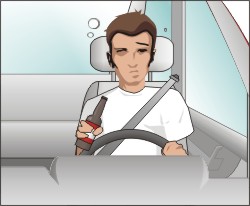
For one of every 100 miles driven in Florida in 2004, a presumed impaired person (BAC .08) sat behind the wheel.5 In 2016, an confirmed total of 5,223 crashes in Florida involved alcohol. These crashes killed 417 and injured 3,160 people. 4
The following statistics from the 2016 publication of the Florida Department of Highway Safety and Motor Vehicles are an excellent indication of how alcohol and driving affect everyone, and it also highlights which age groups are impacted most significantly.
Alcohol Confirmed Drivers Below Age 504
| Age Group | Fatal | Incapacitating | Non-Incapacitating | Possible | Injuries |
|---|---|---|---|---|---|
| 15-17 | 0 | 1 | 2 | 5 | 26 |
| 18-20 | 9 | 15 | 26 | 20 | 191 |
| 21-24 | 29 | 47 | 75 | 63 | 528 |
| 25-29 | 51 | 46 | 96 | 93 | 542 |
| 30-34 | 25 | 31 | 53 | 47 | 416 |
| 35-39 | 18 | 28 | 33 | 40 | 340 |
| 40-44 | 30 | 25 | 29 | 31 | 273 |
| 45-49 | 26 | 26 | 37 | 38 | 318 |
Costs
A study by West Virginia University showed that alcohol is a factor in 30% of Florida crash costs. Alcohol-related crashes in Florida cost the public $10.9 billion in 2005 , including $4.3 billion in monetary costs and over $6.6 billion in quality of life losses. Alcohol-related crashes are deadlier and more serious than other crashes. People other than the alcohol impaired driver paid $6.7 billion of the alcohol-related crash bill.
Costs Per Alcohol-Related Injury
- The average alcohol-related fatality in Florida cost $5.2 million
- $1.7 million in property costs
- $3.5 million in quality of life losses
- The estimated cost per injured survivor of an alcohol-related crash averaged $ 154,000
Costs Per Drink
The societal costs of alcohol-related crashes in Florida averaged $ 1.20 per drink consumed in 2004. People other than the alcohol-impaired driver paid $ 0.70 per drink.
Impact on Auto Insurance Rates
In -related crashes accounted for an estimated 17% of Florida's auto insurance payments. Reducing alcohol-related crashes by 10% would save $210 million in claims payments and loss adjustment expenses.
Prevention Savings
Florida already has many important impaired driving laws. However, a number of additional strategies can be used to mitigate the harm from impaired driving.
- Enforcing Serving Impaired Persons Law: Using undercover police officers to enforce Florida's law against serving alcohol to impaired bar and restaurant patrons would reduce alcohol-related crash fatalities by an estimated 11%. It would cost $ 0.50 per licensed driver and save $ 40 per licensed driver.
- Sobriety Checkpoint Program: Intensive enforcement of Florida's BAC limit with highly visible sobriety checkpoints would reduce alcohol-related fatalities by at least 8% and save $ 112,400 per checkpoint. Including costs of travel delay and the value of mobility losses by impaired drivers apprehended and sanctioned, the cost of conducting a checkpoint would average $ 15,900, including police resources.5
Other Hazardous Acts and Distractions
Drivers can participate in other hazardous acts that may or may not be related to alcohol consumption. They include the following:
- Aggressive driving/road rage - Speeding, tailgating, running red lights, running stop signs, unsafe maneuvers, riding on the shoulder, and a general disregard of public or personal safety are all signs of aggressive driving. More than 13,000 people have been killed since 1990 in crashes due to aggressive driving. When aggressive driving escalates into road rage and somebody becomes injured or killed, it becomes a criminal offense with the title of "road rage." Road rage occurs when drivers allow the aggressive driving committed by them or others to affect their driving and judgment, letting their anger get the best of them and turning their automobiles into 3,000-pound weapons.
- Speeding - Speeding is one of the most prevalent factors in crashes. In 2016, speeding was a contributing factor in 27 percent of all fatal crashes, and 10,111 lives were lost in speeding-related crashes. Speeding affects the way a driver handles a vehicle because it prevents the driver from being able to control the vehicle around curves and bends. It increases braking distance. It also increases the distance that the vehicle travels before the driver can react to a dangerous situation.6
- Cellular phones - In 1985, there were 345,000 cell phones. In 2002, there were more than 135 million cell phone users. Cell phones distract drivers, preventing them from driving in a safe manner. Dialing, searching for a number, or even reaching for the phone can distract the driver just long enough to cause a crash. In addition to cell phones, drivers can have computers and wireless printers installed in their vehicles, making their vehicles virtual offices, places to work and not drive. It is very dangerous to try to work and drive at the same time.7
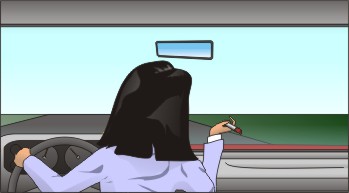 Grooming - Have you ever seen a driver driving the car and putting on mascara or lipstick or shaving at the same time, with their eyes in the rearview mirror and not on the road? This is extremely dangerous.
Grooming - Have you ever seen a driver driving the car and putting on mascara or lipstick or shaving at the same time, with their eyes in the rearview mirror and not on the road? This is extremely dangerous.- Eating - Trying to drive and hold a sandwich or reach for French fries at the same time can distract a driver long enough to cause a crash.
- Reading maps, newspapers, books, or magazines - Having your eyes on a book and not on the road is a very hazardous situation.
Summary - We have seen it all and are probably all guilty of some form of hazardous act or distraction at one time or another. But according to the National Highway Traffic Safety Administration, distractions caused almost 10% of all fatal crashes nationwide in 2016.8
1 NHTSA Traffic Safety Facts 2016 - Overview https://crashstats.nhtsa.dot.gov/Api/Public/ViewPublication/812580
2 NHTSA Traffic Safety Facts 2016 - Occupant Protection https://crashstats.nhtsa.dot.gov/Api/Public/ViewPublication/812494
3 The Economic and Societal Impact Of Motor Vehicle Crashes, 2010 http://www-nrd.nhtsa.dot.gov/Pubs/812013.pdf
4 Florida Traffic Crash Statistics Summary - https://firesportal.com/Pages/Public/DHSMVDocuments.aspx
5 Impaired Driving In Florida 2004 (most current data available) - http://www.hsc.wvu.edu/icrc/AHRQpdfs/FL7.pdf
6 NHTSA Traffic Safety Facts 2016 - Speeding https://crashstats.nhtsa.dot.gov/Api/Public/ViewPublication/812480
7 NHTSA - National Center for Statistics and Analysis - Cell Phone Use on the Roads in 2002 (Pub 2005) p 15
8 NHTSA - Distracted Driving https://www.nhtsa.gov/risky-driving/distracted-driving
3. Crash Dynamics
- Effect of speed on force of impact
- What happens in a crash and the concept of 1st, 2nd and 3rd collision
- Energy absorption in relationship to vehicle design and direction of impact
3. 1. Effect of speed on force of impact
Your car performs as a result of natural laws and energy of motion working together. When you drive a 3,000 pound car at higher speeds, these forces are much greater. You may have a hard time maintaining control at highway speeds or in unusual situations that require you to make an emergency stop.
To maintain control of your car, you must understand the effects of these forces. By staying alert and ready to act, you can apply what you know and reduce possible conflicts.
To better understand crash dynamics (what happens in a crash), we need to look at what are called the Laws of Motion, as discovered by Sir Isaac Newton, who is generally recognized as the father of mechanics.
Newton's First Law
A body at rest tends to remain at rest, while a body in motion tends to remain in motion, unless it is acted upon by an unbalanced external force.
This law describes the concept of inertia. If you are riding in a car at x speed and have to stop suddenly, or if your vehicle strikes another object, it is the inertia of your body that resists the stopping, causing you to slide forward against your seat belt.
Newton's Second Law
The acceleration of a body is directly proportional to the force acting on the body, while it is inversely proportional to the mass of the body. The energy an object has as it moves is called kinetic energy, or energy of motion. The faster your vehicle moves, the more kinetic energy it has. Kinetic energy is the force that a vehicle carries and that must be absorbed by the car in a crash. Newer cars crumple upon impact and absorb kinetic energy.
Kinetic energy increases dramatically as weight and speed increase. If your speed triples, you need nine times the distance to stop.
Once you understand kinetic energy, you can adjust to traffic situations ahead of time. You can see how important it is to always reduce your speed in an emergency situation. When you cut your speed in half, you cut your kinetic energy by four times.
Newton's Third Law
For every force exerted on a body by another, there is an equal but opposite force reacting on the first body by the second.
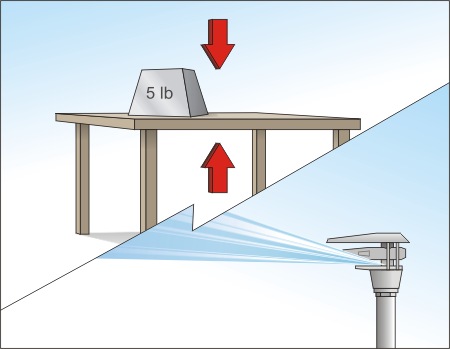
For every action, there is an equal but opposite reaction. If there is a five-pound weight sitting on a table, the weight pushes down on the table with a force of five pounds. Similarly, the table pushes up on the weight with a force of five pounds. A simple dynamic example of this law of motion is a whirly-gig lawn sprinkler. The water leaving the arms of the sprinkler exerts a force on the arms of the sprinkler, which makes them rotate.
Although friction is not considered one of the laws of motion, it is important to understand it as it relates to crashes. We have a love-hate relationship with friction. If you are driving your car and have to stop quickly, you want as much friction as possible; however, to get maximum mileage from your car, you want less friction.
One definition of friction is that it is the resisting force that has to be overcome when one body moves in contact with another body. One thing we need to understand is that the force of friction between two objects sliding together is dependent on the material of the two objects sliding. An example of this is a tire sliding on the road. We all understand that the more friction we have, the sooner we stop. Wet roads have less friction than dry roads, so it will take you longer to stop on wet roads.1
Newton's Laws of Motion help you understand the effect of speed on the force of impact in a motor vehicle crash. The faster your vehicle is traveling at the time of the crash, the more kinetic energy the vehicle has, and this kinetic energy must be dissipated if the vehicle comes to a stop (crashes). The higher the speed, the greater the impact - and the greater the risk of serious injury and death to the vehicle occupants.
3. 2. What happens in a crash and the concept of 1st, 2nd and 3rd collision
Have you ever wondered what happens inside a car when it crashes? People at crash test labs do. They spend hour after hour measuring, testing and analyzing. They've found that in every car crash, there are actually three collisions.
- The car's collision
- The human collision
- The human body's collision
THE CAR COLLISION
During a collision, the car crashes to a stop. At 30 mph, a car hitting an object that is not moving will crumple in about two feet. As the car crushes, it absorbs some of the force of the collision.
THE HUMAN COLLISION
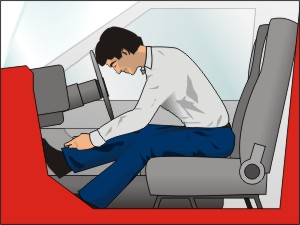
The second collision is the "human collision". At the moment of impact, the driver and passengers in the car are still traveling at the vehicle's original speed. When the car comes to a stop, the driver and passengers continue to be hurled forward until they come in contact with some part of the automobile, such as the steering wheel, the dashboard and the front window, or the back of the front seat. Humans can also cause serious injuries to other humans when they collide with each other. Rear-seat passengers often hit people in the front seat of the car as they fly forward with incredible force.
THE HUMAN BODY'S COLLISION
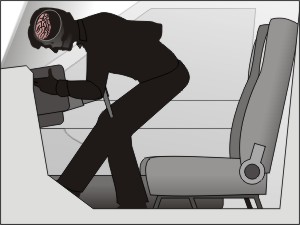
In a crash, even after a human body comes to a complete stop, the internal organs are still moving. When they stop moving, these internal organs slam into other organs or the skeletal system. This "internal collision" often causes serious injury or death. Imagine what happens when someone's head collides with the windshield of a car. After the person stops moving, the brain hits the inside of the skull. This could result in a range of injuries, from a mild concussion to permanent brain damage.
HOW TO PREVENT SERIOUS INJURIES IN A CRASH
Wear your safety belt, including the shoulder harness, properly; it has been proven to work in the crash test lab and on the road.
DID YOU KNOW?
- Three out of four crashes happen within 25 miles of home, at a speed of 45 miles per hour or less.
- About 40% of all fatal crashes occur on roads where the posted speed limit is 30 miles per hour or less.
- Motor vehicle crashes cost American taxpayers over 277 billion dollars every year.1
3. 3. Energy absorption in relationship to vehicle design and direction of impact
The energy absorbed by a vehicle in a crash is highly variable. Remember that force at impact is kinetic energy. The formula is K.E. = 1/2 mv2, which translates to: Kinetic energy is equal to one half (1/2) of the mass of the vehicle (m) times its speed (v) squared. In other words, a VW bug is no match for a Mack truck traveling at a similar speed.
Energy is absorbed by 1) vehicle design; 2) the area of the vehicle struck; 3) the type of material; and 4) the support in that area of the vehicle. All vehicles have what is known as a stiffness coefficient value. This value dictates the coefficient of restitution of a given vehicle.
In plain language, let's take a ball of modeling clay and a billiard ball. If we drop the billiard ball from three feet onto a marble floor, the ball will return to or very near the three feet height. That is a value of 1. When we drop the clay ball from the same three feet, it remains on the floor. There is no return. That is a value of 0. The billiard ball is very elastic, while the clay ball is very plastic. Vehicles are designed with both plastic and elastic values to absorb energy forces in a manner that will reduce the direct forces that reach the vehicle occupant(s).
Energy absorption is directly dependent on vehicle speed, angles of collision, and areas of vehicle contacts. In any given collision, each vehicle will experience a Delta V, or change in speed, during the moment of collision. Depending on each vehicle's initial speed, this Delta V takes only milliseconds. There is very little time for the vehicle components to collapse, bend, fold or crumple in a manner that will protect the precious cargo within.
A simple in-line direct rear-end collision will make use of energy absorbing bumpers on the front of the bullet vehicle and the rear of the target vehicle, if both are passenger-type vehicles. Depending on the speed of the vehicle, energy forces may not be absorbed by the bumper systems alone. Large trucks do not have energy absorption bumper systems and mass is much greater, so considerably more energy will be transmitted to the occupants.
Angular collisions are different. Crashes at acute angles may be considered sideswipe collisions, as opposed to 90-degree "T-bone" crashes. Typically, the larger the angle, the more energy is transmitted to the occupant compartment. The angles between the vehicles at collision are called Principal Direction of Force angles and are equal and opposite as stated in Newton's Laws of Physics: "For every action, there is an equal and opposite reaction."
One important thing to remember is that the greater the speed and mass, the more energy and force is created. No vehicle can protect people from every crash situation, even with all the safety restraint systems in use. Speed is a major factor in dictating how much energy the vehicle can absorb to protect the occupants.
1 New NHTSA Study Shows Motor Vehicle Crashes Have $871 Billion Economic and Societal Impact on U.S. Citizens http://www.nhtsa.gov/About+NHTSA/Press+Releases/2014/NHTSA-study-shows-vehicle-crashes-have-$871-billion-impact-on-U.S.-economy,-society
2 The Linear Elastic - Plastic Vehicle Collision - Tawney, Simon
4. Crash Prevention Techniques
- SIPDE, including distance guidelines and adaptation to surroundings
- Following distance, including two-second minimum, when to increase speed and dealing with tailgaters
- Stopping distance in relationship to speed
- Environmental hazards, rain, slick roads, standing water, fog and wind
- Vehicle emergencies, tire failure, brake failure and loss of power steering
- Sharing the road with large trucks and vulnerable road users
- Passing laws with information on clear distance and prohibitive situations
- Right of way, including the concept that no driver can claim the right of way and what to do when traffic lights malfunction
- Speed adjustments in relationship to environmental hazards, surroundings, school zones and construction zones
- Wireless communications
- Railroad crossings
4. 1. SIPDE, including distance guidelines and adaptation to surroundings
Safe driving depends, to a great extent, on your ability to correctly analyze a traffic situation and react to it. Good seeing habits are most important for responsible driving. However, just being able to see well is no guarantee you will see all critical clues or make correct responses. The driving task is primarily a thinking task. Driving is about 10 percent physical and 90 percent mental. Physically, all you can do is start, stop and turn your car. All the rest is mental. Responsible drivers use a system that helps them deal with most of the traffic possibilities they encounter. These drivers have fewer close calls and collisions than drivers who do not use an organized system.
The SIPDE process is an organized system of seeing, thinking and responding.
- Search
- Identify
- Predict
- Decide
- Execute
SEARCH
Begin by searching the traffic situation to gather information for your decisions and actions. Develop a system of searching for information and clues within and about the driving environment to recognize possible problems ahead, behind and on both sides of your vehicle. You must process this information properly, decide how to avoid conflict and execute the correct actions.
Develop a visual search pattern. A visual search pattern is a process of searching critical areas in a regular sequence. To use a visual search pattern, look for clues in a certain pattern and in a systematic manner.
An example of a visual search pattern for driving straight ahead is:
- Glance ahead.
- Check your rearview mirror.
- Glance ahead again.
- Glance at the side of the roadway or intersection.
- Glance ahead again.
- Check your speedometer and gauge.
- Glance ahead again.
Each glance should only last an instant.
Different driving environments and traffic situations present a variety of visual search problems. Harold Smith introduced a system for safe driving many years ago that is still in use today. The Smith System stresses eye discipline and the idea of space cushion.
- Aim high steering:
To "aim high" means to look far ahead when you drive. Consider this: We do not look at our feet when we walk - we look ahead. Aiming high allows you to be able to analyze traffic situations. In city traffic, look at least one block ahead. On highways and expressways, look as far ahead as possible - at least two to three seconds. - Keep your eyes moving:
Glance near and far, right and left, in mirrors as well as at the instrument panel. Be sure to look ahead often. - Get the big picture:
Getting the big picture is the mental process of putting together the critical clues that your eyes selected and identified as you scanned the driving scene. - Make sure others see you:
You must communicate with other drivers. Communicate your presence or intentions with the lights, the horn, car position, eye contact or body movement. - Leave yourself an out:
Leaving yourself an out means you have identified an escape path in case of a possible conflict. You should adjust your position to keep space around your vehicle in changing traffic conditions. If you do not have at least one available out, adjust your position until you do have one.
IDENTIFY
If you do not know what you are looking for, knowing how, when, and where to look does little good. You must learn to identify specific driving-related clues.
For example, if you identify a line of parked vehicles on a street and front wheels turned towards the street on one of the cars, a motorist may be pulling into your lane. Vapor coming from an exhaust pipe or a driver sitting in the car may also indicate that a parked car may be ready to enter your path of travel.
The kinds of clues you search for differ in different driving environments. In city driving, search for intersections, pedestrians and other traffic. On open highways, search areas much further ahead. Look for crossroads, slow moving vehicles, and animals. When driving on an expressway, search the other lanes ahead, behind, and beside you for other roadway users who might affect your planned path of travel.
Develop the habit of ground viewing. This is when you make quick glances at the roadway in front of your vehicle. Watch for animals and debris on the road.

Always be on the lookout for problem drivers. Problem drivers usually give clues to their driving behavior. Some fast drivers may be problem drivers. They may try to pass without enough room or in a no-passing zone. They might change lanes frequently, trying to get ahead of the normal traffic flow. Distracted or confused drivers may also be problem drivers. Be alert for individuals who are driving with only one hand on the steering wheel while holding a coffee cup, a cellular phone, or a map in the other hand.
The roadway itself is another important area to watch. Identify intersections, hills and curves early. Be aware ahead of time when the width of your lane may be reduced. Multi-lane roadways often narrow into single lane roadways. Identify signs warning you of this change early enough to position your car in the through lane. Always try to avoid making any unnecessary stops in moving traffic.
Identify situations in the roadway that can narrow your lane space, such as standing water, potholes, or objects, early so that you have more time to plan a path around them.
Your identification process should keep you looking constantly for roadside hazards such as pedestrians, bicyclists, parked cars and animals. Watch for shopping center entrances, roadside stands, and restaurants.
Identify the roadway surface and conditions each time you begin to drive. You may need to make adjustments if the weather changes while you are driving. Roadway surfaces may be dry when you start out and then become wet and slippery with rain.
Identify traffic controls as early as possible so you are ready to make the correct response.
PREDICT
Once you have identified a possible hazard, predict how this hazard might create a conflict. When you predict, you interpret the information you have identified. You anticipate where possible points of conflict might occur. You try to foresee what might happen and how it could affect your path.
Analyzing a situation is part of predicting, and is a basic part of responsible driving. Often, you will be faced with more than one possible hazard, so predicting is a complex issue.
Predicting involves what is happening, what could happen and, if it does happen, how it might affect you. To predict, you must evaluate the situation and make a judgment about the possible consequences. The more complex a situation is, the more difficult it is to identify and predict.
Making a judgment about a traffic situation involves measuring, comparing, and evaluating. As you drive, you judge speed, time, space, distance, traction and visibility. You make judgments about your own driving performance as well as the actions and performance of other drivers.
When predicting the actions of others, do not assume that other roadway users will always take the correct action. Instead, watch for clues about what they might do. The responsible driver predicts that other roadway users, including drivers and pedestrians, will make mistakes.
The most important predictions to make concerning the actions of other drivers are: Where will the other driver go? What actions will the other driver take? Is more than one action possible? When will the action be taken? Where might I be when the action happens? Where might our paths cross?
You should also attempt to predict when pedestrians may step out in front of you. By making this prediction, you will be able to slow or stop in order to avoid a conflict.
Always be prepared to adjust your speed for varying conditions and situations. Different traffic, roadway, and weather conditions can change the amount of time and space needed for slowing down and for braking control.
DECIDE
Once you have identified a situation and predicted a possible conflict, you must decide upon an action to avoid the conflict. There is probably no task more important for a driver than making wise decisions in time to avoid conflict. There may be times when you fail to identify every clue in a situation. Other users will often take actions you did not predict. The decisions you make in these situations become the basic factors for your safe driving. Be prepared to change your plans to avoid a conflict.
Any decision you make will be influenced by your own speed and the speed of other vehicles. Many drivers think that slowing down is the only way to avoid a conflict, but it is not. A quick maneuver may also be required.
You can decide to change your position within your lane or you might change lanes to the left or right. The Smith System guideline of "leave yourself an out" tells you to change your position when necessary. You will then have an escape path to use in order to avoid conflict. Having more than one escape path is ideal, which means having a space all around your vehicle.
The decision to communicate with others helps reduce the chance of a conflict. The Smith System Rule, "make sure others see you," tells you to let others know where you are and what you plan to do.
You may use your lights to give signals to other drivers. Your brake lights signal other drivers that you intend to slow or stop. Using your turn signals tells other drivers that you plan to turn or change lanes. Your emergency flashers convey the message "I am in trouble" or "I cannot move." (Four-way emergency flashing lights on a moving vehicle is a violation of Florida Law.) White back-up lights let others know that you are backing up or intend to back up. (Look for back-up lights on cars in parking lots as a clue for a possible conflict.) Parking lights warn other drivers that you are parked along the side of the roadway. Try to develop eye contact with other drivers. You can communicate many messages this way. If there is a possibility of conflict, check to see if the other person is looking at you. (While eye contact often helps reduce the risk of conflict, it does not guarantee that there will not be conflict.)
Execute
Carrying out your decisions in order to avoid conflict is the "execute" step in the SIPDE process. This step involves the physical skills used in driving. In most cases you will execute routine maneuvers and actions.
Executing the decision to accelerate means you have judged the speed and use of space by others. You might accelerate to get out of another driver's way or to avoid an obstruction in the roadway. Remember that different vehicles have different acceleration capabilities. Consider your own vehicle's capabilities before executing a decision to accelerate.
When you have decided to decelerate, or brake, to reduce risk, you should have already considered the surface of the roadway. The amount of braking needed will vary with the speed of your car and the condition of the roadway. When braking suddenly, check vehicles to the rear. Avoid locking the brakes during an emergency stop. Locked brakes make steering impossible, since wheels must be turning to provide traction for steering.
When you decide to steer away from a conflict, execute just the amount of steering needed. Oversteering can cause you to lose control of your vehicle, especially at higher speeds. Higher speeds also require more space for your maneuver.
You will often need to execute a combination of actions. You might need to accelerate and steer at the same time. In another situation, you might need to brake, communicate, and steer at the same time. The precision and timing with which you execute these actions determines whether or not a conflict will occur.
4. 2. Following distance, including two-second minimum, when to increase speed and dealing with tailgaters
FOLLOWING TOO CLOSELY

The concept of one car length of space between two vehicles for every ten miles per hour has been rendered obsolete by the NHTSA (National Highway Traffic Safety Administration) research. The primary reason for this is that people have difficulty judging what one car length is consistently. Furthermore, at fifty-five miles per hour, a vehicle travels 80.63 feet in one second (55 mph multiplied by a conversion factor of 1.466 equals 80.63 feet per second). If a driver has accurately judged fifty-five feet of distance between his vehicle and the vehicle ahead and has to stop, the car will travel 60.47 feet before the driver can even begin to apply the brakes during the average reaction time of three-quarters of a second, all but assuring a collision. If you maintain a minimum (for clear, dry weather) of a two-second interval between you and the car ahead, at fifty-five mph you will have a 161.3-foot buffer ahead within which to react and stop.
When you are following another vehicle in your lane, you should have at least a two-second cushion between your vehicle and the one ahead. Pick out a stationary object ahead of the car in front of you, such as, a white line across the road, the shadow of an overpass, or a parked car on the shoulder. Start counting when the lead vehicle passes that spot: one-thousand one, one-thousand two. If you have passed the spot you selected before you complete your two-second count, you are too close. Take your foot off the gas and slow down until you are at a safe distance, or change lanes if it is safe.
There are times when two seconds' following distance is not enough. The two-second rule is a minimum. Additional seconds need to be added for darkness, bad weather, large vehicles, vehicles towing other vehicles, vehicles following others too closely, or any other less-than-ideal situations. Two seconds is the short- or close-range environment, which you should scan for immediate hazards. Drivers should also look at least ten seconds ahead of their vehicles to be aware of medium-distance potential hazards. Always try to keep a safe area around you. Keep from getting boxed in and not having a way out if someone presents a hazard. The law does not allow for any good reason for hitting another vehicle in the rear. F.S. 316.0895 (1) states: "The driver of a motor vehicle shall not follow another vehicle more closely than is reasonable and prudent, having the regard for the speed of such vehicles and the traffic upon, and the conditions of, the highway." 1
4. 3. Stopping distance in relationship to speed
The faster we drive, the further it will take us to stop. Several things must be considered to determine stopping distance.
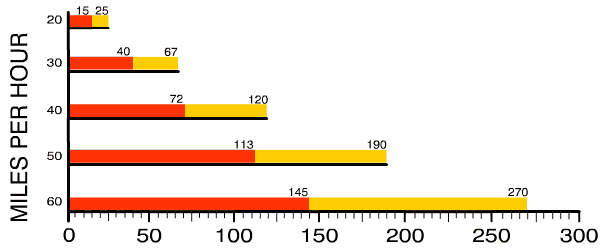
The above graph indicates the reaction (red) and braking (gold) distance for the total braking distance at various speeds.
Your mental and physical conditions are very important.
Your age, use of drugs including some prescription and over-the-counter medications, and physical fatigue will all affect your ability to react to a potential hazard, or perception and reaction time. Reaction time in daily driving averages 1.5 seconds with various driving distractions.
The vehicle is another important factor to be considered in stopping distance. Worn or under-inflated tires negatively affect stopping distance. Vehicles must have brakes that meet certain standards; if brakes are not working properly, stopping distance will be affected. Whether or not your vehicle has an Anti-locking Brake System (ABS) must be considered as well.
Road and weather conditions must be considered. As we discussed in another section, friction is the most important factor in stopping a vehicle. Conditions such as wet roads or roads made of gravel reduce traction and increase stopping distance.
When you are forced to stop, three things must happen. You must perceive the hazard or warning; you must react to the hazard; and you must use your brakes to stop.
The length of time you take to identify, predict, and decide to slow for a hazard is called your perception time. You cannot consistently estimate your perception time because your ability to perceive will change from time to time. By scanning and maintaining the proper spacing method that we discussed earlier, you will perceive hazards earlier and allow yourself more reaction time.
Once you know a hazard exists, the length of time you take to execute your actions is your reaction time. An average driver's reaction time is 3/4 of one second in clinical laboratory settings, but reaction time in the driving environment is an average of 1.5 seconds. If you are impaired due to alcohol, drugs or fatigue, your reaction time will increase; thus the time required to stop and

The distance your vehicle travels from the time you apply the brakes until your vehicle stops is called braking distance. This distance will change depending on your driving abilities, your vehicle's condition, and the conditions of the road. Estimating stopping distance can be difficult, so it is better to utilize the two second rule. This rule enables you to project your approximate stopping distance under ideal conditions at any speed.
Don't forget - the higher the speed, the longer the braking distance. At higher speeds, you will have a harder time controlling your vehicle. A vehicle with worn tires or bad brakes needs a longer distance to stop. Check your tires frequently for low air or worn tread. If the brakes on one side of your car are worn or out of adjustment, your vehicle may pull to one side in a stop - if this happens, get the brakes checked immediately. If you panic and slam on your brakes you might lose control of your car in an emergency situation. Be alert at all times, but stay calm in an emergency. Remember, wet road surfaces will reduce traction on the road and increase your braking distance. Reduce your speed if it begins to rain during your drive.
4. 4. Environmental hazards, rain, slick roads, standing water, fog and wind
We drive in environmental conditions each time we make a trip. Understanding better how to handle changing conditions will make the trip more enjoyable and safer. Dealing with too much light, such as sun in your eyes, may be handled by wearing sunglasses or properly using the sun visor. For safety reasons, keep the lower edge of the sun visor pushed toward the windshield when in use.
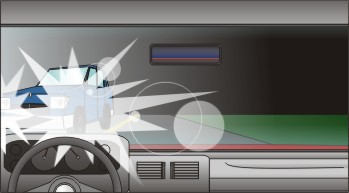
Night driving means there will be changes that you must deal with successfully. Aside from reducing detail, darkness conceals hazards: pedestrians, bicycles, stalled cars, curves and other objects or conditions. You must make a decision on the basis of a sketchy and incomplete picture. At night, it is more difficult to judge the speed and position of other vehicles. You must depend largely on your headlights, which will show only a relatively short and narrow path ahead. Light does not bend around corners, so you must reduce your speed on curves to a point where your headlights illuminate the road ahead. Usually, adequate highway lighting is limited. Glare from roadside lighting and the headlights of oncoming vehicles may impair your visibility. Keep your panel lights as dim as possible for better vision, while using enough panel light to read your speedometer and other gauges. Reduce speed as much as is necessary to stop within the visible distance. Increase seeing distance by keeping the headlights clean and properly aimed and the windshield clean.
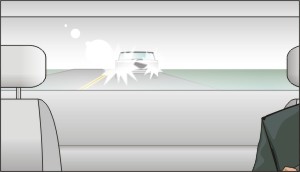
There are other visibility conditions we must consider to drive safely, such as fog, haze, smoke and mist. These conditions can affect our visibility greatly. Florida law requires that we turn on our low beam headlights and use our windshield wipers in rainy weather. Never drive with only your parking lights on. Be alert for slow-moving or stopped traffic. Check your rearview mirrors frequently for vehicles that are approaching quickly from the rear. Be especially careful for patches of fog in valleys and low-lying areas. If possible, drive slowly but keep moving. If conditions are too difficult, pull over as far to the right as possible, off the main travel portion of the roadway, and stop. Leave your parking lights on and activate your hazard lights.
Driving in the rain is a hazard we must consider. When the roads are wet, stopping distance is increased. When braking, friction between your tires and the surface of the roadway affects your stopping distance. Wet roads have less friction and increase the distance it takes you to stop. Also, driving through water may cause hydroplaning. The tread on a tire prevents hydroplaning, which is one reason the law requires tire treads to meet certain standards. As little as 1/16 of one inch of water can cause hydroplaning.
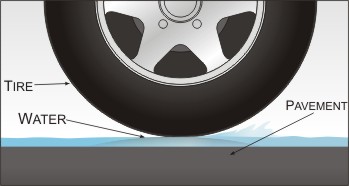
Hydroplaning occurs when your tires ride on a thin layer of water and do not touch the road. When the car is riding on a film of water, there is no friction between your tires and the road. Hydroplaning also affects your ability to steer and brake.
Do not drive through large bodies of standing water, which can affect brake performance and the vehicle's electrical system and can cause engine failure, which could result in costly repairs. If the standing water is concentrated on one portion of the road and only one side of the vehicle goes through the water, the vehicle will often pull in that direction. The force of the pull is dependent on the depth of the water and the speed of the vehicle.
As you approach standing water, lift your foot off the gas pedal and check your rearview mirror for vehicles that are following you too closely.
Remember:
- Slow down before driving through the water.
- Turn your windshield wipers on.
- Tap the brakes as you exit.
- Use caution when checking the outside mirrors. Rain can distort or obliterate images.
- NEVER drive through standing water if you do not know how deep it is.
Wind can also be a problem, especially when driving large vehicles, such as a truck or a motor home. Be alert for cross gusts when leaving overpasses, large buildings or other large areas where the wind was temporarily blocked from striking your vehicle.
Another ongoing problem with wind gusts occurs when you are being passed by large vehicles such as tractor trailers or buses traveling in either direction. Wind gusts from these vehicles can make your car more difficult to control. As these vehicles start to pass you, grip your steering wheel firmly. You may also want to reduce your speed.
Environmental Causes
Florida Traffic Crash Facts – 20162
Lighting Conditions at the Time of Crash
| Lighting Conditions | Fatal Crashes | Injury Crashes |
|---|---|---|
| Not Specified | 4 | 31 |
| Daylight | 1,226 | 61,213 |
| Dusk | 111 | 3,075 |
| Dawn | 42 | 1,640 |
| Darkness | 1,786 | 27,302 |
| Unknown | 7 | 60 |
| Total | 3,176 | 93,321 |
Road Surface Conditions at the Time of Crash
| Surface Conditions | Fatal Crashes | Injury Crashes |
|---|---|---|
| Unknown | 15 | 82 |
| Dry | 2,782 | 81,286 |
| Ice/Frost | 0 | 6 |
| Mud/Dirt/Gravel | 13 | 263 |
| Oil | 1 | 17 |
| Other | 4 | 42 |
| Sand | 2 | 55 |
| Water (standing/moving) | 1 | 26 |
| Wet | 358 | 11,544 |
| Total | 3,176 | 93,321 |
4. 5. Vehicle emergencies, tire failure, brake failure and loss of power steering
When you are driving, things can happen very quickly. You may only have a fraction of a second to make the right move. Here are some guidelines for handling emergencies.
Brake Failure
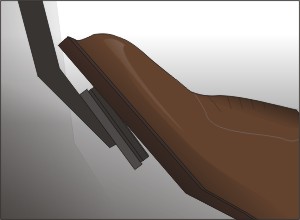
If your brakes fail, pump the brake pedal rapidly several times. You may be able to work up enough pressure to stop the car. If this does not work, shift into the next lower gear. As the car begins to slow down, shift down again. To slow down further, apply the parking brake. You may use your left foot on the parking brake (remember to hold the release button off). Keep in mind the parking brake is a separate braking system and brakes only the two rear wheels. When brakes are overused, such as when driving downhill or with your foot riding on the pedal, they can overheat. The best solution for overheated brakes is to stop and let them cool off. Pull off of the highway to a safe place. Make sure there are no objects on the floor, such as a wadded floor mat or a drink can, that could keep you from being able to press the brake pedal down. It is not safe to try to move an object from under the brake pedal while you are driving. Remember to release the parking brake if you are going to push or tow your vehicle.
Different vehicles have different braking systems. It is important to read your owner's manual so you will know exactly what kind of brakes your vehicle has, so you will know how to react in emergencies.
Breakdown
If your vehicle breaks down, park where the disabled vehicle can be seen for 200 feet in each direction, if possible. Try to safely park the vehicle with all four wheels off the traveled portion of the roadway. Place your car in park if you have an automatic transmission. If your car is equipped with a manual transmission, put your car in gear. Engage the parking brake and turn on your emergency flashers. Tell all passengers to exit the vehicle on the side away from traffic. Raise the hood and tie a white cloth to your left door handle or radio antenna. It is safer to stay with your car than to go for help.
Dead Battery
A dead battery will prevent your car from starting. Consult your owner's manual for correct procedures for "jump-starting" a battery. Jump-starting can be dangerous if you do not have the right equipment or knowledge to perform the task. A battery can explode if jumped improperly.
Fire
Most vehicle fires start in the engine compartment. Quickly steer the vehicle out of traffic and off the roadway to a safe open area. Stay away from buildings and service stations. Turn off the ignition. Tell all passengers to exit the vehicle and move a safe distance from the vehicle. If the fire is small and you have a portable extinguisher, you may attempt to extinguish the fire. Do not raise the hood if the fire is in the engine compartment, as air will cause it to flare up. Never apply water to a gasoline fire. If you cannot control the fire, move a safe distance away from the vehicle due to the possible presence of toxic fumes and/or potential explosion. Make sure someone has called the fire department (911).
Flat Tire or a Blowout
When a front tire blows out, the vehicle pulls strongly in the direction of the deflated tire. You must steer firmly against the pull of the vehicle to keep it on its intended path. A left front tire blowout is especially dangerous, since the vehicle may pull left toward the lane of oncoming traffic. When a rear tire blows out, the back of the car can fishtail. Handle a rear blowout like a skid. Grip the steering wheel firmly and ease up on the accelerator. Avoid braking. Steer the vehicle in the direction you want the front end to go and coast into a safe location. If you are going to change a tire, check the owner's manual for the correct procedure. A tire change should always be performed off the traveled portion of the highway.
Engine Warning Light On
When the engine warning light on your dashboard comes on, it may say "check engine," "check oil" or "hot." As soon as possible, stop your vehicle off the traveled portion of the roadway. Continuing to drive your vehicle may cause severe damage to the engine. Follow the instruction shown on the dash. Never open the radiator cap until the engine has cooled. Check your owner's manual for proper procedures.
Flooded Engine
An engine floods when too much fuel but not enough air reaches the engine. Depress the accelerator fully for 5-10 seconds. Release the accelerator and re-start the engine. If the engine does not start within the allowed time, wait several minutes and try again.
Headlight Failure
If you find yourself suddenly without headlights, stay calm. Do not slam on your brakes. Try turning the light switch and the dimmer switch on and off a few times. Some circuits might still work. Use whatever lights are available to help you drive off the roadway to a safe location. Make sure your vehicle is seen by others by using your directional signals and four-way flashers if they are working.
Hood Flies Up

If your hood flies up while you are driving, brake smoothly to slow the vehicle down. Try looking out the left side window or the gap where the hood hinges to the rest of the vehicle's body to see the road ahead. Use your mirrors to check the rear to see how close the vehicle behind you is before you brake. Turn on your turn signal and exit to a safe location off the roadway.
Jammed Gas Pedal
If you let up on the gas pedal and the engine does not slow, your accelerator pedal is probably jammed. Keep your eyes on the road. Do not tap the gas pedal with your foot as it may stick farther down and cause the car to go faster. Try to pry the pedal up with the toe of your shoe. Never try to reach down to dislodge the pedal yourself; you cannot afford to take your eyes off the road. Shift into neutral. The engine will race faster, but the power will be removed from the wheels. Follow an escape path to a safe place off the roadway. Turn off the ignition when you are off the road and no longer need to change direction.
Power Steering Failure
A failure in the power-steering system is the most common type of steering failure. Power steering failure occurs when the engine dies, the power-steering fluid in the system is low or a drive belt slips or breaks. The steering mechanism will still work, but you must exert much effort to steer. As soon as possible, take the vehicle to a service center to be repaired.
Right Wheels Off the Pavement
If your vehicle leaves the traveled portion of the road because your right wheels are off the pavement, take your foot off the gas pedal and hold the steering wheel firmly. The greater the drop-off between the roadway and the shoulder, the more steering control you need. Keep your car in a straight line. If possible, avoid braking. Wait until the road is clear and return to the pavement at a slow speed.
Skidding
If your vehicle skids, respond quickly and calmly. A vehicle skids when the tires lose their grip on the pavement. Slippery surfaces combined with a sudden movement may cause your vehicle to skid. High speed, especially on curves, may also lead to skidding. When you feel your vehicle begin to skid, take your foot off the gas pedal and do not use your brakes, unless you are about to hit something. Steer into the direction of the skid to straighten the vehicle out. Be prepared to countersteer, if necessary, to straighten the vehicle out, but take care not to overcorrect. Then steer in the direction you wish to go. Straighten the steering wheel as soon as you are going in the correct direction. If you do not straighten in time, the vehicle will begin to skid in the opposite direction. Begin to correct your steering as soon as you go into the skid. The longer you wait, the harder it will be to come out of the skid. All of your steering movements must be quick but smooth. Once you are going straight again, you may begin to accelerate slowly.4
4. 6. Sharing the road with large trucks and vulnerable road users
4.6.1 Sharing the Road with Large Vehicles
In 2016, a total of 4,317 people were killed in crashes involving large trucks (gross vehicle weight rating greater than 10,000 pounds) making up 11.5 percent of all the traffic fatalities reported in 2016.
Large trucks accounted for eight percent of all vehicles involved in fatal crashes. Drivers of large trucks were less likely to have a previous license suspension or revocation than were passenger car drivers. In 2016, 293 people were killed in crashes involving large trucks on Florida's roadways.3
For safety's sake, you must understand all traffic laws, be courteous, abide by the rules of the road and drive responsibly. Large vehicles include not only trucks, but any vehicle you have trouble seeing around, including buses, vans, delivery trucks, motor homes and some sport utility vehicles (SUV). Large vehicles have blind spots on both sides of their vehicles just as smaller vehicles do. These blind spots are called the "no zone." Drivers of large vehicles must use their mirrors to see around them, and as the bumper sticker says: "If you can't see my mirrors, I can't see you." If large vehicles need to swerve or change lanes for any reason and cannot see the vehicles around them, a crash can occur. Try not to stay in the "no zone" of either side of a large vehicle any longer than is necessary.
Another "no zone" is the large area directly behind large trucks. Tailgating large vehicles greatly increases the chance of a rear-end collision. Since you cannot see what the truck driver can see, you must rely on the brake lights of his or her vehicle. By the time you see the truck's brake lights come on, the driver has used up his or her reaction time and has started using up braking distance.
Another "no zone" is just in front of large vehicles. When passing a bus or a truck, be sure you can see the front of the vehicle in your rearview mirror before pulling in front of the vehicle.
Another "no zone" is when a large vehicle is making a wide right turn. The driver of the vehicle may need to swing wide to the left in order to safely negotiate a right turn. If you are directly behind or beside them, the driver will be unable to see you. Cutting in between the vehicle and the curb on the shoulder to the right increases the possibility of a crash.
Another "no zone" is when a truck is backing up. Sometimes a truck must block the street to maneuver its trailer accurately. Never cross behind a truck that is preparing to backup or is in the process of doing so. Most trailers are eight and a half feet wide and can completely hide objects that come between them and loading areas. Drivers attempting to pass behind a truck that is backing up enter a blind spot for both drivers.
4.6.2 Sharing the Road with Vulnerable Road Users
A new law went into effect on July 1, 2014 called the "Aaron Cohen Life Protection Act." This law requires the driver of a vehicle involved in a crash that results in serious bodily injury or death to a person to immediately stop the vehicle, render aid to the victims if possible, and to remain at the scene of the crash until released by law enforcement authorities.
The law was created to strengthen the previous law for "Fleeing the Scene of a Crash" by increasing the minimum mandatory prison sentence and license revocation. The law also defines "Vulnerable Road Users."
The act made the following changes to previous law by:
- Requiring a minimum mandatory prison sentence of four years for a driver who leaves the scene of a crash resulting in the death of another person.
- Raising the minimum prison sentence from two to four years for a driver under the influence of drugs or alcohol who leaves the scene of a crash resulting in the death of another person.
- Requiring a minimum three-year driver license revocation.
- Requires that the driver participate in a "Victim's Impact Panel" or department approved driver training before re-issuance of a driver's license.
- Increasing penalties if the crash involved a "Vulnerable Road User."
A "Vulnerable Road User" means:
- A pedestrian, including a person actually engaged in work upon a highway, or in work upon utility facilities along a highway, or engaged in the provision of emergency services within the right-of-way;
- A person operating a bicycle, motorcycle, scooter, or moped lawfully on the roadway;
- A person riding an animal; or
- A person lawfully operating on a public right-of-way, crosswalk, or shoulder of the roadway such as:
- A farm tractor or similar vehicle designed primarily for farm use;
- A skateboard, roller skates, or in-line skates;
- A horse-drawn carriage;
- An electric personal assistive mobility device; or
- A wheelchair.
Those who are Especially Vulnerable include:
- Children
- Elderly people
- The disabled
Let's take a look at each type of Vulnerable Road Users:
Pedestrians
Of all the highway users, pedestrians are the most vulnerable. It is the special responsibility of drivers to watch for and protect pedestrians. The term pedestrian includes:
- Persons walking on sidewalks adjacent to the roadway, on the roadway where there are no sidewalks, or crossing the street at an intersection whether there is a marked crosswalk or not
- Persons on roller skates, in-line skates, skateboards, or non-motorized scooters.
- Individuals working on the side of the roadway whether in a road construction zone, repairing utilities such as cable, electrical or water lines, or engaged as a part of a sanitation crew.
- Emergency workers, including tow truck operators, at the scene of a crash or other emergency adjacent to the roadway.
In 2016, 5,987 pedestrians were killed in traffic crashes in the United States - an increase of 9 percent from the 5,495 pedestrians killed in 2015. Of the 5,987 pedestrians killed, 667 were in Florida. On average, a pedestrian is killed in a traffic crash every 1.5 hours.
In 2016, one-fifth (22 percent) of all children ages 14 and younger who were killed in traffic crashes were pedestrians. The highest number of pedestrian traffic deaths were in the 10-14 and 50-54 age groups.
During 2016, 26 percent of the pedestrian fatalities occurred between the hours of 6 PM and 8:59 PM.8
Many pedestrians who do not drive are not fully aware of traffic laws, including those that pertain to signals. Many do not know the distance needed to stop a moving vehicle. Never assume that pedestrians will move out of the way. In some situations you may have to stop to allow a pedestrian to cross safely. Try to let them know you are there with a tap on your horn or a hand wave.
Many pedestrians assume that drivers will yield the right of way to anyone in the crosswalk. When they cross at an intersection with a Walk signal, pedestrians may not even look for oncoming traffic.
Pedestrians waiting to cross the street often stand in the street instead of on the curb. They may even dash across the street without warning. During a rainstorm, pedestrians may be more concerned about protection from the weather and pay little attention to moving traffic.
Pedestrians who are engaged in work along the roadway such as emergency personnel, construction, or utility crews may be paying more attention to the job at hand than to the traffic. It's especially important for drivers to slow down and obey the "Move Over Law" (more on this law in Chapter 8) when encountering these types of pedestrians.
Be alert for pedestrians at night, even in well-lit areas. It is often difficult to identify pedestrians at night.
Watch for pedestrians when leaving an alley or driveway. Always stop before crossing the sidewalk and look for pedestrians. You may tap your horn as a warning. Once across the sidewalk, be prepared to yield the right of way to other traffic on the street.
Although a jogger is safer using a sidewalk or jogging path, you may encounter joggers on the street. A jogger who is coming toward you should see you, but a jogger whose back is toward you may not hear you coming. Be aware of joggers who are wearing music headsets as their hearing ability will be compromised.
Pedestrians using skates, in-line skates, or skateboards will be traveling faster and may not be able to stop as quickly as other pedestrians. Be especially watchful for these types of pedestrians.
The moment you step from your vehicle, you are a pedestrian. The knowledge you have about driving should make you more aware of possible problems and conflicts with pedestrians.
Especially Vulnerable Pedestrians
Children
In 2016, one-fifth (20 percent) of all children aged 14 and younger, who were killed in traffic crashes were pedestrians.
Children by their very nature are erratic and difficult to see. Small children often don't fully understand the dangers involved when playing on or near roadways. Teens are impulsive and enjoy the thrill of taking risks. Although it seems teens should know better, they often operate in an "It'll never happen to me!" state of mind. Exercise care when traveling through residential neighborhood, near parks, and school zones. Watch for kids, including teens, who may be near the road. Expect the unexpected.
Elderly People
Older pedestrians (ages 65+) accounted for almost 20 percent of all pedestrian fatalities in 2016.
Florida has an aging population. Native baby boomers are now in their late 60s and the state is a favorite destination for retirees. While they may still be healthy enough to get around, aging knees and hips don't allow them the same kind of mobility and speed they had when they were younger. It may take them a bit longer to cross streets. They may not be able to see or hear well and may be unaware of possible dangers. Be on the lookout when driving through retirement communities and tourist areas and exercise patience at crosswalks.
Blind Persons
The primary traveling aids for a person who is blind are often a white cane and/or a trained guide dog. Independent travel involves some risk that can be greatly reduced when you, the driver, are aware of the use and meaning of a white cane or guide dog.
Drivers must always yield the right-of-way to persons who are blind. When a pedestrian is crossing a street guided by a dog or carrying a cane or walking stick that is white in color or white tipped with red in a raised or in an extended position, all vehicles must come to a complete stop.
Mobility Impaired Persons
Whenever a pedestrian who is mobility impaired (using a wheelchair, crutches, a cane or a walker) is in a crosswalk, it is the driver's responsibility to stop at the intersection to allow the pedestrian to cross safely. Once the pedestrian has crossed safely, the driver may proceed with caution.
If there is no sidewalk, mobility impaired individuals with motorized wheelchairs or three-wheeled scooters may travel on the roadway. Use caution when approaching and give them plenty of clear space when passing.
Current Trends And Devices For The Safety Of Vulnerable Road Users
Complete Streets
A trend is growing in the US for what is known as "Complete Streets." Complete streets is a concept that looks at, not only the safety of motorists but the safety of all road users, including pedestrians and cyclists as well. Many communities throughout Florida are urging their elected officials to consider complete street designs when road improvements are made. Complete streets make use of designated bicycle lanes, safer pedestrian crossings and speed reduction measures.
Speed Reduction Measures
One of the primary dangers to vulnerable road users is speeding traffic. Drivers who are driving too fast have less time to react if they should encounter a vulnerable road user in the road. Speed limit and warning signs aren't enough because they are commonly ignored by impatient drivers. In order to reduce motor vehicle speeds in areas where pedestrian and bicycle traffic is common, traffic engineers are looking at various speed reducing measures such as;
- Roundabouts - Roundabouts are circular intersections without traffic lights that force drivers to slow down while, at the same time, improving the flow of traffic through intersections.
- Speed humps and speed tables - These devices are less aggressive than speed bumps because they allow traffic to proceed at the posted speed limit but speeders can find themselves launching off the far end, landing hard, and possibly causing damage to their vehicle.
- Speed cushions - Speed cushions consist of two or three smaller humps that force most traffic to slow but are narrow enough to allow wider bodied emergency vehicles to straddle them without having to slow.
- Curb extensions - Also known as bulbouts, these extensions narrow the road at pedestrian crossings, forcing drivers to slow and exercise more caution.
- Raised crosswalks - Raised crosswalks act as a speed table forcing drivers to slow when approaching the crosswalk.
Other Vulnerable Road Users
Bicycles
The first automobile crash in the United States occurred in New York City in 1896, when a motor vehicle collided with a bicycle rider (Famous First Facts, by Joseph Kane).
In 2016, 140 bicyclists were killed in Florida and an additional 3,802 were injured in traffic crashes.4
In the United States in 2016, bicyclist fatalities occurred more frequently in urban areas (71 percent), at non-intersection locations (58 percent), between the hours of 6:00 PM and 8:59 PM (20 percent on weekdays and 26 percent on weekends).
Most of the bicyclists killed or injured in 2016 in the United States were males (84 percent), and most were between the ages of 50 and 59 years (24%).5
Cyclists have a right, under the law, to use the roadway and are considered as a vehicle. When using the roadway, cyclists are required to obey all the rules of the road just like motorists. However, their small size and the fact that motorists tend to look for larger vehicles and don't notice cyclists make them particularly vulnerable. Another issue that makes them vulnerable is the impatience of motorists when operating around cyclists.
As the driver of a motor vehicle, give bicycles extra space whenever possible. Some riders may not be able to control their bicycles well and may suddenly get in your path. Be sure to give extra space to young riders, riders who may be distracted, riders who may have been drinking and older riders. As you start to pass, approach slowly and try not to frighten the rider. Before passing, be aware of the possible path the bicyclist may take. Florida law requires bicyclists to ride on the right side of the roadway but a cyclist may swerve into your path for a variety of reasons that you may not be aware of such as potholes, puddles, and storm drains. If you can predict a possible change of direction, you may be able to stop in time to avoid a crash.
Always start your pass well behind the bicycle. You should have at least a half-lane of space between your vehicle and the bicyclist (Florida law requires a minimum of three feet clearance between your vehicle and the cyclist.). If you do not have this much space, wait for a gap in oncoming traffic and then pass. Before you move over to pass, signal to traffic behind you to let them know that you are changing lanes. You may want to warn the cyclist by tapping your horn.
Large three-wheel cycles are popular in some communities especially retirement areas. They provide transportation and exercise. In retirement areas, riders of three-wheel cycles may travel in large groups.
At night, use your low beam headlights when traveling near bicyclists. Avoid shining your high beam headlights into riders' eyes.
When parallel parking, check for all types of pedalcycles before opening the driver's side door.
Complete Streets For Cyclists
As part of the complete streets and speed reduction initiatives, more and more cities are constructing roadways with either bicycle lanes or marking the lanes where cyclists commonly share the roads.

Bicycle lanes will be located on the right side and are marked with both signs on the side of the road and the symbol of a bicycle painted on the pavement. Motorists are not permitted in the bicycle lane unless they are making a right turn. Before turning, make sure to check both your rearview mirror and turn your head to check your blind spot for cyclists approaching from the rear.
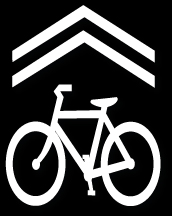
Lanes that are shared between motorists and cyclists are marked with road markings known as "sharrows" as shown on the left. In a shared lane, be aware that cyclists may ride in the center of the lane to avoid obstacles or in preparation for a turn. Use caution and allow plenty of room between yourself and the cyclist when driving in a shared lane.
New types of intersection markings known as "Bike Boxes" and "Advanced Stop Lines" are starting to appear in some Florida cities; especially in cities with large universities like Gainesville and Tallahassee where cycling is a more common mode of transportation. These intersection markings are designed to allow cyclists ahead of motor vehicle traffic in order to make it safer for them to turn or cross intersections. When approaching an intersection with a bike box, or advanced stop line, drivers should give cyclists the right-of-way by slowing, allowing cyclists to merge into the main lane of traffic, and stopping at the white line before the bike box.

Bike Box

Advanced Stop Line
Motorcycles (Including Mopeds and Motorized Scooters)
In 2016, 5,286 motorcyclists were killed in motor vehicle crashes, an increase of 5.1 percent over the 5,029 motorcyclist fatalities in 2015.
Motorcycles made up three percent of all registered vehicles in the United States in 2016 and accounted for only 0.6 percent of all vehicle miles traveled.
In 2016, motorcyclists accounted for 14 percent of total traffic fatalities, 17 percent of all occupant (driver and passenger) fatalities.
Motorcycles are more likely to be involved in a fatal collision with a fixed object than are other vehicles. In 2016, 23 percent of the motorcycles involved in fatal crashes collided with fixed objects, compared to 17 percent for passenger cars, 13 percent for light trucks, and four percent for large trucks.6
Numerous actions that motorcyclists take can affect you. A rider must operate separate brakes for front and rear wheels to stop. In addition, the rider must coordinate foot and hand brakes carefully for maximum braking. If the front brake is applied independently, it can lock the front wheel and cause a loss of control. This may result in crashes with other road users
The motorcycle rider must coordinate the hand throttle, hand clutch and foot gear shift lever to accelerate smoothly. If this action is not performed smoothly, a balance problem may occur. The problem is magnified when a vehicle is following too closely.
Following a motorcycle or a motorcycle following you may cause a problem. You should continuously check your rearview mirror and be aware of motorcycles behind you. When a motorcyclist is following you try not to make any sudden stops.
Rough weather and road conditions present greater problems to the motorcyclist than to the driver of a motor vehicle. Allow extra space for motorcycles in all adverse conditions.
A motorcyclist can't cope with adverse weather conditions as well as the driver of a motor vehicle can. For example, a puddle may hide a pothole that jolts your car. That same hidden pothole could throw a motorcycle out of control.
Just as it is for drivers of motor vehicles, the worst time for a motorcyclist is immediately after it starts to rain. As rain mixes with dirt and oil on the road, traction is greatly reduced. Since balance is important for motorcycles, reduced traction is far more critical to a motorcyclist's control.
When you are following a motorcyclist who is crossing railroad tracks or carrying a passenger, use extra caution. Railroad tracks may present a special problem because motorcycle tires can get caught in the grooves of the crossing, which could result in the rider losing balance. You should predict that the rider might lose balance and/or control at a railroad crossing.
Motorcycle Licensing
How to Get a Motorcycle Also License
All persons requesting a motorcycle endorsement:
- Must hold a Class E license or higher or meet the requirements for a Class E license.
- Must complete a motorcycle safety course, Basic RiderCourse (BRC), or
- Provide an out-of-state license with a motorcycle endorsement (except Alabama).
How to Get a Motorcycle Only License
Under 18
- Must hold a Learner's License at least 12 months prior to the issuance of a Class E Motorcycle Only license.
- Must have NO moving traffic violation convictions 12 months from the issue date of the learner's license.
- Must provide completion of an approved motorcycle safety course.
Over 18
- Pass the vision, road sign and road rule examinations or hold a current Learner's License.
- Must provide completion of an approved motorcycle safety course.
For more information visit: http://motorcycles.hsmv.state.fl.us
Source: http://motorcycles.hsmv.state.fl.us7
Animals and Horse-Drawn Vehicles
Visitors to cities like St. Augustine may regularly encounter horse-drawn sightseeing carriages and in the more rural areas of Florida, it may not be uncommon to encounter persons riding on horseback along the side of the road. In these instances, it's the animal that a driver needs to be aware of and to use caution when approaching. No matter how experienced or well-trained the rider may be, the animal can always be unpredictable and can easily be spooked.
Since you will be approaching at a much higher speed, the riders may not be aware of your presence until you are very close. Slow down when approaching riders or carriages and make sure you have plenty of clear space to go around.
Never honk your horn, yell, or do anything else that could startle the horse.
Always be prepared for unpredictable movements on the part of the animal.
Farm, Agricultural, or Construction Vehicles
In the rural areas of Florida, especially during harvest time, you may encounter tractors, combines, or other types of slow-moving farm vehicles. In, or near construction zones, you could encounter road graders or other types of heavy construction equipment. These vehicles have a right to use the road and should have a slow-moving vehicle sign attached to the back of the vehicle.
These slow-moving vehicles are generally incapable of traveling at more than 25 mph and their large size may make it difficult for the operator to see traffic approaching from behind. Exercise caution and patience when encountering these types of vehicles. Wait until the road ahead is clear before attempting to pass.
4. 7. Passing laws with information on clear distance and prohibitive situations
Passing on a two-lane road, meeting traffic
Drivers of vehicles proceeding in the opposite direction shall pass each other on the right and each driver shall give to the other at least one-half of the main-traveled portion of the roadway, as nearly as possible.
When you observe an oncoming vehicle, check to see if it is traveling on or near the centerline. If it is, slow down by removing your foot from the accelerator and cover the brake pedal. Move to the right position in your lane. Check the condition of the shoulder in case you need an escape path. The later at night it is, the more important it is to watch the oncoming traffic; be aware that the drivers may be sleepy or intoxicated.
Passing in the same direction on a two-lane road:
First, make sure you are in a passing zone, with no solid yellow lines on your side of the centerline. Check for oncoming traffic that could interfere with your pass. Can you tell how fast oncoming vehicles are approaching? Are there other vehicles ahead of the vehicle you are passing? Before starting your pass, look for vehicles that may be entering the highway from a side road, either to travel in the lane in which you are passing or to travel in the lane to which you will be returning when you complete your pass. Check for vehicles that may be following you or in the process of passing you. Stay a safe distance behind the vehicle you want to pass. The closer you get to the vehicle, the less you can see ahead. This is especially true when passing large vehicles. Before you start to pass, signal to drivers behind you by using your turn signal. When you have completed your pass, do not return to the right side of the roadway until it is safe and you are clear of the vehicle you have passed. You must return to your lane before coming within 200 feet of any approaching vehicle. Before you move back into your lane, signal your intention to return to that lane.
Passing on the right.
You may pass on the right if:
- the vehicle ahead is making a left turn or is about to make a left turn.
- the roadway has an unobstructed pavement not occupied by parked vehicles and is of sufficient width for two or more lanes of moving traffic in each direction.
- you are on a one-way street with two or more lanes.
When passing on the right, you must do so only under conditions permitting such movement and in no event shall such movement be made by driving off the pavement or main travel portion of the roadway.
When you may not pass
You may not pass on a two-lane road with traffic moving in the opposite direction under certain conditions:
- When you see a "Do Not Pass" or "No Passing Zone" sign.
- When a solid yellow line is painted on your side of the centerline.
- When approaching the crest of a hill or a curve in the roadway where the driver's view is obstructed within such a distance as to create a hazard. This is due to the possibility that another vehicle may be approaching from the opposite direction.
- When approaching within 100 feet of or traversing any marked intersection.
- When approaching within 100 feet of or traversing any railroad grade crossing.
- When the view is obstructed upon approaching within 100 feet of any bridge, viaduct or tunnel.
Being passed
When you are being passed, maintain your speed; do not speed up or slow down. Help other drivers pass you safely by moving to the right side of your lane to give them more room and a better view of the road ahead. At night, switch to your low beam headlights when someone is passing you.
4. 8. Right of way, including the concept that no driver can claim the right of way and what to do when traffic lights malfunction
The law does not give the right-of-way to anyone; it only says who must yield the right-of way. Every driver, motorcyclist, moped rider, bicyclist and pedestrian must do everything possible to avoid a crash. When must you yield the right of way? Every driver of a vehicle shall yield the right-of-way to:
- A pedestrian worker and flagperson engaged in maintenance or construction work on a highway when lawfully notified by a warning device of that person.
- An escort vehicle or pedestrian flagperson that is engaged in the management of highway movement of an oversize vehicle, when the driver is warned of the presence of the vehicle or person.
- A publicly-owned transit bus traveling in the same direction which has signaled and is re-entering the traffic flow from a specifically designated pullout bay.
- A vehicle which has entered the intersection from a different highway.
- All vehicles approaching on a state-maintained highway when you are about to enter or cross the state-maintained road from a paved or unpaved road that is not controlled by a traffic control device.
- All vehicles approaching on a paved county or city maintained road from an unpaved road that is not controlled by a traffic control device.
- Any vehicle approaching from the opposite direction which is within the intersection or so close thereto as to constitute an immediate hazard when turning to the left within the intersection or into an alley, private road, or driveway.
In addition, the driver on the left shall yield to the vehicle on the right when both vehicles have entered an intersection from different highways at the same time.
Every vehicle must yield the right-of-way at intersections that are controlled by stop signs, yield signs and traffic signals or as directed by a police officer.
When you approach an intersection in which the traffic lights are inoperative, you should stop as if the intersection is controlled by a stop sign. (See F.S. 316.1235)
4. 9. Speed adjustments in relationship to environmental hazards, surroundings, school zones and construction zones
As you travel the roadways in the state of Florida, you will see signs which state the "speed limit." These signs tell you the maximum limit allowed by law under ideal conditions. Some examples of when the speed limit may be too fast to follow.
Environmental Hazards
Heavy rain reduces your ability to see and be seen. In daytime turn on your windshield wipers, low beam headlights and, if needed, your windshield defroster. Heavy rain at night can almost blind you. Driving at the speed limit under those conditions is too fast. You should reduce your speed limit under those circumstances.
Fog reduces your ability to judge distance. Oncoming vehicles may be closer than you think. Be alert and be prepared to slow down. You may need to pull off the pavement until conditions improve; if so, remember to turn on your emergency flashers to warn other drivers that you are stopped.
Dawn and dusk are also examples of environmental hazards. Try to make your car more visible to others. Turn on your low beam headlights, not only so you can see better, but so others can see you better.
Road Obstructions
Although expressways are built to keep traffic moving, conditions sometimes slow or halt traffic flow. One of these situations is highway construction. Watch for warning signs that tell you when you are approaching a construction area. In Section 8, you will see examples of those signs. The closer you get to the construction area, the more you need to use caution and obey special speed limitations. You may see lighted signboards and/or cones as you get closer to the construction area. The number of traffic lanes may be reduced. Check your mirrors and your blind spot before merging to be sure that the lane is clear. Trucks and other equipment may be using some or all of your traffic lane. Watch for trucks pulling away from the area. They may leave mud or sand on the road. Slow down, steer gently and obey workers' instructions. Be especially careful of workers and equipment operators who may not see you. Always use an extra space cushion to protect them.
Car Crash
An expressway crash may cause blockage of one or more lanes. When you see a problem ahead, check your mirrors for traffic behind you, flash your brake lights and slow down gradually. Watch for emergency personnel and for police officers directing traffic. If you can go around the crash scene, proceed cautiously. Do not stop unless otherwise directed. Do not slow to a crawl to look at the crash. You will only slow traffic and may even cause another crash.
Night Driving
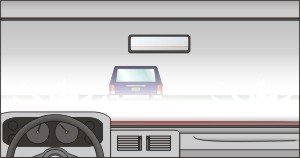
Night driving brings on a new set of circumstances that make the speed limit too fast for conditions. When driving at night, always keep your headlights on. High beams will permit you to see further ahead, but you should only use them when there is no oncoming traffic for at least 500 feet and you are at least 300 feet behind if following another vehicle.
Use your low beam headlights in bad weather. Use of your high beams in heavy rain or fog will reflect the light back into your eyes.
Sometimes drivers do not realize that they have their bright lights on. If an oncoming driver does this, do not put on your bright lights. Slow down and glance down at the right edge of the road as a guide for your lane position. Do not stare directly into the oncoming lights to avoid being blinded.
Overdriving Your Headlights
Overdriving your headlights is driving at a speed that makes your stopping distance longer than the distance illuminated by your headlights.
School Zones
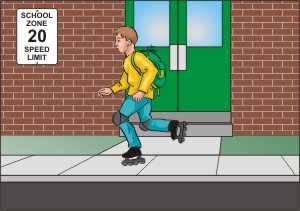
As a driver you must know what school zone and school crossing signs look like. School zones signs usually indicate the hours of enforcement in addition to the school zone speed limit of a minimum speed of 15 miles per hour to a maximum speed of 20 miles per hour. These speed limits are strictly enforced for the safety of children. Sometimes the signage will be accompanied by a flashing yellow light. You may refer to Section 8 for examples of the signs.
School zones present different conditions in the form of children walking, running or riding bicycles, school buses, vehicles driven by parents and school crossing guards. You must look at each child in a school zone as a human caution sign.
Note: Fines for speeding violations are doubled in a school zone.
Construction Zones
Construction zones may utilize a combination of several different types of traffic management devices. You may encounter a flagperson giving you instructions about when to proceed or when to stop. You may also see signs, traffic cones or barricades with flashing yellow lights giving direction.
Often the Department of Transportation gives you advance notice when they will be doing roadwork so drivers can make alternative travel plans. However, if you do not get advance notification and you get caught in traffic, be patient, stay calm and stay within the speed limit. Besides the safety risks, speeding fines are doubled in construction zones.
F.S.316.183 - Unlawful Speed
- No person shall drive a vehicle on a highway at a speed greater than is reasonable and prudent under the conditions and having regard to the actual and potential hazards then existing. In every event, speed shall be controlled as may be necessary to avoid colliding with any person, vehicle, or other conveyance or object on or entering the highway in compliance with legal requirements and the duty of all persons to use due care.
- On all streets or highways, the maximum speed limits for all vehicles must be 30 miles per hour in business or residence districts, and 55 miles per hour at any time in all other locations. However, with respect to a residence district, a county or municipality may set a maximum speed limit of 20 or 25 miles per hour on local streets and highways after an investigation determines that such a limit is reasonable. It is not necessary to conduct a separate investigation for each residence district. The minimum speed limit on all highways that comprise a part of the National System of Interstate and Defense Highways and have not fewer than four lanes is 50 miles per hour.
- No school bus shall exceed the posted speed limits, not to exceed 55 miles per hour at any time.
- The driver of every vehicle shall, consistent with the requirements of subsection (1), drive at an appropriately reduced speed when:
- Approaching and crossing an intersection or railway grade crossing.
- Approaching and going around a curve.
- Approaching the crest of a hill.
- Traveling upon any narrow or winding roadway.
- Any special hazard exists with respect to pedestrians or other traffic or by reason of weather or highway conditions.
- No person shall drive a motor vehicle at such a slow speed as to impede or block the normal and reasonable movement of traffic, except when reduced speed is necessary for safe operation or in compliance with law.
- No driver of a vehicle shall exceed the posted maximum speed limit in a work zone area.
- A violation of this section is a non-criminal traffic infraction, punishable as a moving violation as provided in Chapter 318.
Driving Slowly In The Passing Lane
A new law (F.S. 316.081) that went into effect in July of 2013 makes it illegal to drive too slowly in the left or passing lane. Under the new law, drivers who drive more than 10 mph under the posted speed limit may be issued a ticket. Drivers, even if they are doing the speed limit, should reserve the left lane for vehicles that want to pass. Unless you are passing another vehicle or preparing to make a left turn, you should stay in the right or center lane. Once you pass another vehicle, you should return to the right. Remaining in the left lane is dangerous because anyone who drives in a manner that causes traffic to back up behind them could cause other drivers to become frustrated and angry and that may lead the other drivers to tailgate or engage in some other type of risky behavior such as passing when there isn't enough clear space to pass.
4. 10. Wireless communications
Since the introduction of cellular telephones in 1983, there have been dramatic changes in the cellular industry. With a growth rate of about 40 percent per year and now, according to a Pew Research poll, 91% of adults in the United States have a cell phone. Changes in technology, including the transition from heavy, cumbersome and expensive cellular telephones, to inexpensive smartphones have had a significant impact on when, where and how we conduct our affairs, both business and personal. Societal pressures for increased efficiency, more leisure time, and an improved sense of safety have placed wireless communications at the forefront of potential situations for an increasingly mobile and technologically sophisticated populace.
While voice communications has been the primary focus of the cellular industry, the desire to "work on the road" has resulted in a move toward the integration of technologies. This trend is such that cellular communications can now be the focal point of a truly "mobile office" including E-mail, fax, and internet services in addition to telephone, voice-mail and paging capabilities from any location.
Indeed, time spent commuting, caught up in traffic and just plain traveling can now be productive. In addition, the cellular telephone brought with it a sense of security for those concerned about traveling alone in unfamiliar areas or concerned about vehicle breakdown. It is not surprising then, that, according to Distraction.gov, at any given moment during daylight hours, over 481,000 vehicles are being driven by someone using a hand-held cell phone.
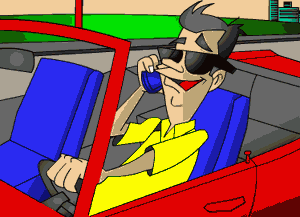
The recent growth of cellular telephone use crosses all ages and gender boundaries. More than just the latest electronic toy, cellular telephones have become an integral part of our business and personal lives. They are used to schedule appointments, broker deals, call for assistance, report emergencies (auto crashes, impaired drivers and reckless driving) and maintain contact with loved ones.
Specific aspects of cellular telephone use have been identified which demonstrate that phone conversation, rather than dialing, is the most frequently reported related factor in crashes. Contrary to expectation, the majority of drivers were talking on their phones rather than dialing at the time of the crash. A few drivers were also startled when their phones rang, and as they reached for their phones, they ran off the road. Other driver factors included driving too fast for conditions or failing to yield while talking on the phone. The overwhelming majority of cellular telephone users were in the striking vehicle and struck cars or other large objects that were in clear view of the driver. There are studies that show that cellular telephone use is a growing factor in crashes. Driver inattention is the most frequently cited pre-crash condition for drivers who use cellular telephones.
In Florida and some other states, cellular emergency calls are directed to the state police (*FHP on your cellular phone). The state police surveyed are generally appreciative of the quick notification capabilities afforded by cellular telephones. Be sure your reason for calling is a true emergency before using *FHP to call for assistance.
Florida Ban on Texting While Driving Law
A new law (F.S. 316.305) that went into effect on July 1, 2013, makes it illegal to manually enter letters, number or data into an electronic communications device while driving. This ban includes texting, emails, and instant messages and applies to any type of electronic communications device.
There are three main types of distraction:
- Visual-taking your eyes off the road
- Manual-taking your hands off the wheel
- Cognitive-taking your mind off what you're doing
While all distractions can endanger drivers' safety, texting is the most alarming because it involves all three types of distraction. (NHTSA)
Recent advances in technology have blurred the line between cell phones, GPS devices, PDA's and computers. While these devices can be very helpful, they can also increase the risks associated with their use.
Some interesting statistics on Distracted Driving:
- Nine percent of fatal crashes in 2016 involved reports of distracted driving. (NHTSA).
- Of those killed in distracted-driving-related crashes, 486 involved reports of a cell phone as a distraction (14% of fatalities in distraction-related crashes). (Source: Insurance Institute for Highway Safety)
- In 2016, 3,450 people were killed on U.S. roadways and in 2015, an estimated 391,000 were injured in motor vehicle crashes that were reported to have involved distracted driving. (NHTSA)
- The age group with the greatest proportion of distracted drivers was the under-20 age group; 9 percent of all drivers younger than 20 involved in fatal crashes were reported to have been distracted while driving. (NHTSA)9
- Using a cell phone while driving, whether it's hand-held or hands-free, delays a driver's reactions as much as having a blood alcohol concentration at the legal limit of .08 percent. (Source: University of Utah)
The Governors' Highway Safety Administration (GHSA) offers these 10 tips for managing some of the most common distractions:
- Turn it off. Turn your phone off or switch to silent mode before you get in the car.
- Spread the word. Set up a special message to tell callers that you are driving and you'll get back to them as soon as possible, or sign up for a service that offers this.
- Pull over. If you need to make a call, pull over to a safe area first.
- Use your passengers. Ask a passenger to make the call for you.
- X the Text. Don't ever text and drive, surf the web or read your email while driving. It is dangerous and against the law in most states.
- Know the law. Familiarize yourself with state and local laws before you get in the car. Some states and localities prohibit the use of hand held cell phones.
- Prepare. Review maps and directions before you start to drive. If you need help when you are on the road, ask a passenger to help or pull over to a safe location to review the map/directions again.
- Secure your pets. Pets can be a big distraction in the car. Always secure your pets properly before you start to drive.
- Keep the kids safe. Pull over to a safe location to address situations with your children in the car.
- Focus on the task at hand. Refrain from smoking, eating, drinking, reading and any other activity that takes your mind and eyes off the road. (www.GHSA.org)
Distracted driving and the use of wireless devices underscore the importance of being an aware driver. Some driving behaviors that indicate that another driver may be distracted include:
- Driving below the speed limit
- Swerving
- Driving off road, or in the middle of the roadway
- Braking frequently
- Head movements
The best defense against distracted drivers is defensive driving. If you use the SIPDE process to handle distracted drivers, you can increase your chances of avoiding potential collisions.
SIPDE stands for Search, Identify, Predict, Decide, and Execute.
Search - your eyes should be constantly moving to look ahead, behind, and on both sides. Be aware of what is happening around you.
Identify - Find the distracted drivers or potential distractions. The distracted driver may be eating, drinking, talking or texting on the phone, reading a map, etc. Also identify the distractions like the person in the banana suit or a car that is pulled over on the side of the road. These are things can cause a driver to take their eyes off the road.
Predict - Try to predict the potential problems. Will the distracted driver weave into another lane? Will they see the traffic stopped ahead and be able to stop in time? Consider what could happen and be prepared to take action.
Decide - Decide what action you need to take to avoid the potential hazard. Should you move into a different lane? Should you decrease your speed? Increase your following distance? Know what you will do to avoid a conflict.
Execute- If what you predicted occurs, you are prepared to make the necessary move. Now you take the action needed. Steer away from the conflict, apply brakes, or accelerate to get out of the way. These are just a few things you can do to avoid the conflict.
Distracted drivers are a danger to themselves, other drivers, bicyclists and pedestrians. The extra technologies in vehicles require that extra diligence be given to commit to be distraction free.
Drivers must concentrate on the road and traffic while driving. You must not carry out activities while driving which negatively impact the operation of the vehicle.
4. 11. Railroad crossings
There is a regulation in baseball which says that if the ball and the runner reach first base at the same time, the tie goes to the runner. In traffic, if a train and a car get to a crossing at the same time, the tie goes to the train. With this understanding, let's look at some ways to keep from having a fatal tie at a railroad crossing.
Railroad crossings are a type of intersection, and like highway intersections, they can be very dangerous. Railroad crossings have their own unique markings; you will see examples at the end of this section.
There are two types of railroad crossings: controlled and uncontrolled. Controlled crossings usually have both red lights and crossing gates. You must make a complete stop when the lights are flashing and/or the gates are down. Remain stopped until the lights stop flashing and the gates are raised. F.S.316.1575(2) states that it is illegal to drive through, around or under any crossing gate that is closed or is being opened or closed.
An uncontrolled railroad crossing does not have red lights or a crossing gate. However, like controlled crossings, uncontrolled crossings are marked with a round yellow advance warning sign placed ahead of the crossing. This advance warning sign tells you to slow down, look and listen for a train. Be prepared to stop at the tracks in the event that a train is approaching. A crossbuck sign marks the railroad crossing. Some of the more dangerous crossings may have a stop sign. If this is the case, the same laws apply as at a highway intersection.
When you approach a crossing, slow down and check traffic in the rear. Be aware of other cars approaching you at an unsafe speed. Reduce the noise level in your car to listen for the train sounds by turning the volume on your radio all the way down. If necessary, lower your window.
Stop at a safe distance before the tracks if a train is approaching - not less than fifteen feet or more than fifty feet. When the train has passed, make sure the intersection is clear and that another train is not approaching on another track before you attempt to cross. A sign below the crossbuck will indicate how many sets of tracks you will be crossing.

When crossing the railroad tracks, reduce your speed to handle a potential rough ride. Check both ways on the track for a short sight distance. Drive onto the tracks only when you have enough space and speed to clear the tracks. Make sure any vehicles ahead of you have cleared the tracks before you start to cross. Never stop on railroad tracks waiting for traffic ahead to move.
Be prepared to stop behind large vehicles, such as school buses and trucks hauling flammable contents. The law requires such vehicles to stop at all railroad crossings.
Highway-Rail Grade Crossing Warning Signs

Round Yellow Advance Warning Sign
Round black-on-yellow warning signs are placed ahead of public highway-rail intersections. The Advance Warning sign tells you to slow down, look and listen for a train, and be prepared to stop if a train is coming.

Pavement Markings
Pavement markings have the same meaning as Advance Warning signs. They consist of an X with the letters RR and the no-passing marking on two lane roads. There may also be a NO PASSING ZONE sign on two-lane roads at railroad crossings. There may be a white Stop Line painted on the pavement before the railroad tracks.
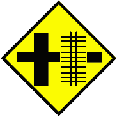
Parallel Track Sign
These signs are diamond-shaped with black illustrations showing railroad tracks parallel to the highway. These signs warn drivers who are making a turn that there is a highway-rail intersection immediately after the turn.
Stop Sign
A Stop sign means the same at a railroad crossing as it does at a highway intersection. Stop, look, and listen for the train. Proceed only when it is safe to do so.
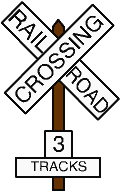
Multiple tracks
When there is more than one set of tracks at a railroad crossing, there is a sign beneath the crossbuck with a number indicating how many tracks are present. Watch for additional trains coming from either direction.
Do Not Stop On The Tracks Sign
This sign may be posted on the right side of the road or on the far side of the tracks. When you stop, be sure that the front (or the rear) of the car is at least 15 feet from the tracks.

Exempt Sign
There are two kinds of Exempt signs:
- A sign below the crossbuck with a white background and black letters that says Exempt
- A sign below the advance warning sign with a yellow background and black letters that says Exempt
An Exempt sign means that the crossing has been abandoned or its use discontinued. Follow local regulations about stopping.
Track Out Of Service Sign
This sign may be posted at a crossing that has been abandoned or its use discontinued. Follow your local regulations about stopping.
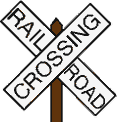
Crossbuck Sign
This sign marks the grade crossing. It means you must yield the right-of-way to the train. If there is no white line painted on the pavement, you must stop before the crossbuck sign.
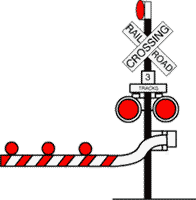
Gates/Lights
NEVER attempt to go around the gates at a railroad crossing. When the red lights are flashing, a train is present. Even if the red lights continue to flash and no train appears, do not cross. Call the police. There may also be an 800 number posted at the crossing to call for help. If there is a flagperson or police officer directing traffic at a railroad crossing, obey that person. You can cross the tracks if that person directs you to do so.
When the gates are down, it means a train is present. It is unsafe and illegal to cross.
1 FSS 316.0 895 (1)
2 Florida Traffic Crash Statistics Summary - 2016, https://firesportal.com/Pages/Public/DHSMVDocuments.aspx
3 NHTSA Traffic Safety Facts 2016 - Large Trucks https://crashstats.nhtsa.dot.gov/Api/Public/ViewPublication/812497
4 Florida Traffic Crash Statistics Summary - 2016, https://firesportal.com/Pages/Public/DHSMVDocuments.aspx
5 NHTSA Traffic Safety Facts 2016 - Bicyclists and Other Cyclists https://crashstats.nhtsa.dot.gov/Api/Public/ViewPublication/812507
6 NHTSA Traffic Safety Facts 2016 - Motorcycles https://crashstats.nhtsa.dot.gov/Api/Public/ViewPublication/812492
7 Florida Rider Training Program https://www.flhsmv.gov/driver-licenses-id-cards/motorcycle-rider-education-endorsements/
8 NHTSA Traffic Safety Facts 2016- Pedestrians https://crashstats.nhtsa.dot.gov/Api/Public/ViewPublication/812493
9 NHTSA Teen Distracted Driving Data Sheet https://crashstats.nhtsa.dot.gov/Api/Public/ViewPublication/812504
5. DUI Prevention
- Effect of alcohol and other drugs on driver capabilities, including judgment, vision, reaction time and the order in which these effects occur
- Relationship of the amount of alcohol consumed to BAC and the equivalence of different types of alcoholic beverages
- Legal consequences, including the increasing severity with repeated offenses and financial consequences of DUI (personal and societal)
- Ways to avoid driving impaired
5. 1. Effect of alcohol and other drugs on driver capabilities, including judgment, vision, reaction time and the order in which these effects occur
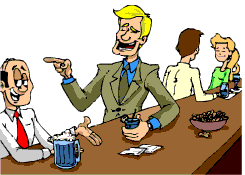
Drinking alcoholic beverages and other drug use is widely accepted in our society. Advertisers often portray drinking as glamorous and sophisticated. Yet the abuse of drugs, including alcohol, is costly. It takes its toll in broken relationships, poor health, wasted lives and sometimes death.
This problem is greatly compounded when someone who drinks alcohol or uses other drugs also drives. A great number of collisions involve drivers who use alcohol and/or other drugs.
All states now enforce a minimum drinking age of 21. Nevertheless, alcohol-related crashes are still a top safety problem.
Many people who use alcohol do not realize that it is a drug. The word alcohol is the commonly used term for the chemical substance ethanol, grain alcohol, or ethyl alcohol.
The effects of alcohol vary from person to person. Equal amounts of alcohol affect different people in different ways. Even though the severity of its effects vary, alcohol affects everyone who uses it. One of the most serious problems of alcohol is that of the drinking driver. The demands of the driving task are so great that every driver needs to be in the best condition possible. A person cannot afford to increase the risk of driving by having his or her skills reduced by alcohol.
Everyone needs to know how alcohol affects the mental and physical abilities needed for safe driving. Even non-drinkers will interact with impaired drivers on the roadway. Everyone who drives needs to know the importance of non-drinking.
When you consume alcohol, most of the alcohol is not digested. It is quickly absorbed directly into the bloodstream through the walls and lining of the stomach and small intestines. Once alcohol enters the bloodstream it is quickly circulated to the brain. Alcohol has its greatest effect on the parts of the brain that control judgment and reasoning, the most critical skills needed by drivers. Physical abilities become impaired soon after.
A driver affected by alcohol has a decreased ability to reason clearly and to make sound judgments. However, the driver may feel as though thinking and judging abilities are sharper and quicker than usual. Some people have a false sense of confidence after they have a drink or two. For example, some people think they can dance or even play pool better after a few drinks. There is nothing a person can do better after having a drink than she or he could do before having the drink. Drinking does not increase your ability to do anything better than you could before.
In addition, alcohol quickly diminishes the ability to concentrate. A decrease in the ability to concentrate greatly increases a driver's level of risk. A person's driving ability can be reduced after only one drink. A person's driving ability decreases as the amount of alcohol in a person's body increases. An alcohol-impaired driver is less apt to interpret correctly what he or she sees.
Alcohol also weakens a driver's inhibitions, which are the inner forces of one's personality that hold back or restrain one's impulsive behavior. A driver's inhibitions weaken as the alcohol content in the body increases. The person who is drinking may drive too fast, take needless risks or even drive into emergency situations without knowing or even caring what's happening.
As more alcohol enters the bloodstream, the area of the brain that controls muscular movements and body control begins to slow down. Even after the driver recognizes danger, the brain takes longer than normal to process the information and react to the danger. Messages the brain sends to different parts of the body might become confused.
The muscular reactions of a driver who has been drinking can become slow and clumsy. Steering and braking movements can become uncoordinated. The driver might over-steer, brake late or not brake at all. The driver might not be able to negotiate turns properly and safely. Such actions cause drinking drivers to be involved in serious crashes. Alcohol affects a driver's ability to see clearly. Night vision, peripheral vision, color vision, and depth perception are all impaired. Visual acuity, sharpness of vision, and peripheral vision are also reduced.
Alcohol also affects the reflex action of the eyes. At night, this impairment can be critical. As the headlights of oncoming vehicles come closer, the pupils of the eyes normally become smaller to shut out excess light. This reflex keeps the driver from being blinded by the glare of headlights. When the lights have passed, the pupils enlarge again to let in all available light.
But after only a few drinks, this reflex action is impaired. The pupils do not become small rapidly as bright lights approach, and they are slow to open after bright lights pass. As a result, the driver can be blinded temporarily and may continue to have blurred vision for some time after meeting each vehicle. For example, if a drinking driver is traveling 70 miles per hour and it takes three seconds for his or her pupils to return to normal, the person has driven over the length of a football field (100 yards) without being able to see.
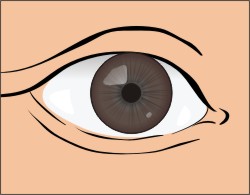
Peripheral vision is also impaired by alcohol. When peripheral vision is narrowed, a driver must turn and look to the sides for potential problems. After a few drinks, though, drivers are usually not aware of restricted side vision. Therefore, they do not make the effort to turn and look to the sides. They are creating a hazard.
Once judgment and reasoning are affected, a person's actions and behavior change. Just one drink can affect a person's behavior. The same amount of alcohol does not affect all people the same way. Alcohol does not even affect one person the same way in all situations. The same person could have two different reactions to alcohol on two separate occasions.

One common effect of alcohol on behavior is a feeling of well-being. This feeling is known as euphoria. Some people with this euphoric effect think they can do anything. This feeling is only a state of mind, because alcohol depresses, or slows down, the working of the nervous system.
Alcohol-induced euphoria can cause people to take chances they normally would not take. This behavior can be deadly behind the wheel of a vehicle.
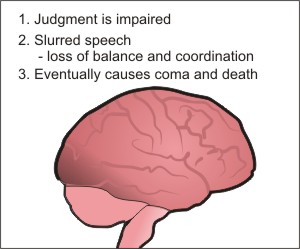
Alcohol can also change other types of behavior. People who drink often become angry or sad. Many become silly or even rude. Some of the resulting behavior depends on the person's personality as well as the mood they were in when they begin to drink. Alcohol is often thought to be a mood enhancer. This means that when a happy person drinks, in most cases he will be happier; when an angry person drinks, in most cases she will get angrier. The best way to avoid these changes in behavior is to decide not to drink.
People who drink and drive can be a hazard to themselves and to others on the highway. Even a small amount of alcohol can increase the driving risk.
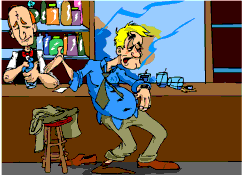
One of the most dangerous behaviors drivers can participate in is what has become known as impaired driving. When a driver is impaired and operating a motor vehicle, it is often because the driver has been consuming alcohol, but drivers can be impaired after using other drugs, both legal and illegal. Let's look at what impaired drivers are doing to others on our highways.
In 2016, 10,497 people were killed in alcohol-impaired-driving crashes. These alcohol-impaired-driving fatalities accounted for 28 percent of the total motor vehicle traffic fatalities in the United States.
Traffic fatalities in alcohol-impaired-driving crashes increased by 1.7 percent from 910,320 in 2015 to 10,497 in 2016.
The 10,497 fatalities in alcohol-impaired-driving crashes during 2016 represent an average of one alcohol-impaired-driving fatality every 50 minutes.
In 2016, all 50 States, the District of Columbia, and Puerto Rico had by law created a threshold making it illegal per se to drive with a BAC of .08 or higher. Of the 10,497 people who died in alcohol-impaired-driving crashes in 2016, 6,479 (62%) were drivers with a BAC of .08 or higher. The remaining fatalities consisted of 3,070 motor vehicle occupants (29%) and 948 non-occupants (9%).
The rate of alcohol impairment among drivers involved in fatal crashes was 3.3 times higher at night than during the day ( 30% versus 9%).
In 2016, 14 percent of all drivers involved in fatal crashes during the week were alcohol-impaired, compared to 26 percent on weekends.
In fatal crashes in 2016 the highest percentage of drivers with a BAC level of .08 or higher was for drivers ages 25 to 34 (27%), followed by ages 21 to 24 (26%).
The percentages of drivers involved in fatal crashes with a BAC level of .08 or higher in 2016 were 25 percent for motorcycle operators, 21 percent for passenger cars and 20 percent for light trucks. The percentage of drivers with BAC levels of .08 or higher in fatal crashes was the lowest for large trucks (2%).
In 2016, 5,013 passenger vehicle drivers killed had a BAC of .08 or higher. Out of those 5,013 driver fatalities for which restraint use was known, 64 percent were unrestrained.
Drivers with a BAC of .08 or higher involved in fatal crashes were 4.5 times more likely to have a prior conviction for driving while impaired (DWI) than were drivers with no alcohol (9% and 2%, respectively).
In 2016, 83 percent (9,885) of the 11,929 drivers with a BAC of .01 or higher who were involved in fatal crashes had BAC levels at or above .08, and 54 percent (6,496) had BAC levels at or above .15. The most frequently recorded BAC level among drinking drivers in fatal crashes was .16.1
In fatal crashes in 2016 a higher percentage of motorcycle riders had blood alcohol concentration (BAC) of .08 grams per deciliter (g/dL) or higher than any other type of motor vehicle driver. The percentages for vehicle riders involved in fatal crashes was 25 percent for motorcycles, 21 percent for passenger cars, 20 percent for light trucks, and 2 percent for large trucks.1
In 2016, 25 percent of all fatally injured motorcycle riders had BAC levels of .08 g/dL or higher. An additional 7 percent had lower alcohol levels (BAC .01 to .07 g/dL).
The percentage with BAC .08 g/dL or above was highest for fatally injured motorcycle riders among age group 35-39 (38%) followed by the 45-49 age group (37%) and age group 40-44 (32%).
Thirty-seven percent of the 1,970 motorcycle riders who died in single-vehicle crashes in 2016 had BAC levels of .08 g/dL or higher. Fifty-five percent of those killed in single-vehicle crashes on weekend nights had BACs of .08 g/dL or higher.
Motorcycle riders killed in traffic crashes at night were over three times more likely to have BAC levels of .08 g/dL or higher than those killed during the day (40% and 12% respectively).
The reported helmet use rate for motorcycle riders with BAC levels .08 g/dL or higher killed in traffic crashes was 50 percent, compared with 65 percent for those with no alcohol (BAC = .00 g/dL).2
Alcohol involvement - either for the driver or for the pedestrian - was reported in 48 percent of the traffic crashes that resulted in pedestrian fatalities. Of the pedestrians involved, 33 percent had a blood alcohol concentration (BAC) of .08 grams per deciliter (g/dL) or higher. Of the drivers involved in fatal crashes, only 13 percent had a BAC of .08 g/dL or higher, less than one-half the rate for the pedestrians. 3
5. 2. Relationship of the amount of alcohol consumed to BAC and the equivalence of different types of alcoholic beverages
WHAT IS AN AVERAGE DRINK?
An average 12 ounce can of beer (5% alcohol), an average 5-ounce glass of wine (12% alcohol) and an average ounce-and-a-half of whiskey (40% alcohol) all contain about the same amount of alcohol. Remember, not all beer is 5% alcohol, not all wine is 12% alcohol and not all whiskey is 40% alcohol; this is only a guideline. Some drinks contain more alcohol than a beer or a glass of wine or a shot. For example, a Long Island Iced Tea contains rum, gin, vodka, tequila and triple sec - almost three ounces of alcohol. A drink like this is not considered "one drink."
WHAT IS BAC?
Blood Alcohol Concentration (BAC) is the amount of alcohol in an individual's body, measured by the weight of the alcohol in a volume of blood. The BAC determines the amount of alcohol that can be consumed before an individual is presumptively impaired.
There are several ways to test an individual's BAC. The most common method used by law enforcement officers is the breath-testing device, which measures the alcohol level in the breath from the lungs. BAC can also be determined by drawing blood and measuring the amount of alcohol in the blood itself. Blood alcohol concentration is directly correlated with the degree of impairment an individual displays when driving after drinking. Although an individual may not exhibit gross signs of impairment, he or she is nevertheless impaired, even at a BAC level lower than that allowed by most state laws.
There is no formula to determine BAC solely from the amount of alcoholic beverages consumed. BAC levels vary from person to person, and can vary within an individual on a case-by-case basis. An individual's BAC depends on the person's gender, weight, metabolism, the time period over which the alcohol was consumed, and the amount of food that was in the stomach prior to drinking. Although a person's BAC can be estimated, the level cannot be determined solely by the number of drinks consumed, and cannot be precisely calculated by a person's height and weight.
Blood alcohol concentration laws are different for drivers under the age of 21 because it is already illegal for these individuals to buy, possess or consume alcoholic beverages. Zero tolerance laws make it illegal for those under the age of 21 to drive after consuming any amount of alcohol, so the legal limit for these drivers is .02.
Presumption of impairment is .08 BAC. The reason for such a presumption is that everybody reacts to alcohol differently. Individuals can be the same sex, height and weight, and drink the same amount of alcohol, and one individual can be visibly far more impaired than the other.
HOW DO YOU SOBER UP?
Black coffee? Exercise? Cold shower? Sorry, but these are not much help. Give an impaired driver a cup of coffee and you have a wide-awake impaired driver. Run him around the block and you now have a wide-awake, tired impaired driver. Put him in a cold shower and now you have a wide-awake, tired, cold, clean impaired driver.
Time is the only way to sober up. About 90% of the alcohol a person drinks will be oxidized by the liver, which takes time. One to five percent of the alcohol is given off unchanged in urine, perspiration, and expired air. (The expired air is used by the police to measure your BAC.) The remainder of the alcohol in the blood is oxidized or burned up by various organs of the body. Each drink of alcohol increases the number of liver cells destroyed and eventually may cause cirrhosis of the liver. This disease is eight times more frequent among alcoholics than non-alcoholics. The most dramatic and noticeable result of alcohol abuse is its effect on the brain. Alcohol depresses the brain centers, resulting in these progressive effects: lack of coordination, confusion, disorientation, stupor, anesthesia, coma, and death. Alcohol kills brain cells and can cause permanent brain damage. Alcohol abuse over a period of time causes loss of memory, judgment, and learning disability.
5. 3. Legal consequences, including the increasing severity with repeated offenses and financial consequences of DUI (personal and societal)
PENALTIES FOR DUI:
First Conviction:
- Fine: Not less than $500 to $1,000. With BAC level of .15 or higher or minor in the vehicle, not less than $1,000 or more than $2,000.
- Community Service: Mandatory 50 hours
- Probation: Not more than one year
- Imprisonment: Not more than six months. With BAC of .15 or higher or minor in the vehicle, not more than nine months.
- Driver License Revocation: Minimum 180 days
- DUI School: Twelve hours DUI School requirement; evaluation conducted to determine need for treatment.
- Ignition Interlock Device: Not less than six continuous months if convicted of driving with; a BAC of .15 or higher or, with a minor child in the vehicle or, if court ordered.
Second Conviction:
- Fine: $1,000 - $2,000. With BAC .15 or higher or minor in the vehicle, not less than $2,000 or more than $4,000.
- Imprisonment: Not more than nine months. If the second conviction is within five years, mandatory imprisonment of at least 10 days; 48 hours of confinement must be consecutive.
- License Revocation: Minimum 180 days revocation; second conviction within five years, five year revocation
- DUI School: 21 hours.
- Evaluation conducted to determine need for treatment
- Ignition Interlock Device: Minimum of one continuous year.
Third Conviction
- Fine: Not less than $2,000 and not more than $5,000. With BAC .15 or higher or minor in the vehicle, not less than $4,000
- Imprisonment: Not more than 12 months; for the third conviction within 10 years, mandatory 30 days in jail; 48 hours must be consecutive.
- License Revocation: Minimum 180 days; third offense within 10 years after second conviction, 10 year revocation
- DUI School: 21 hours. Evaluation conducted to determine need for treatment
- Ignition Interlock Device: Minimum of two continuous years.
Fourth or More Conviction
- Fine: Not less than $1,000.
- Imprisonment: Not more than five years.
- License Revocation: Permanent revocation
- Ignition Interlock Device: Five Years4
FINANCIAL CONSEQUENCES OF DUI
The average DUI costs between $8,000 and $12,000 in fines and court costs. When attorney's fees, insurance increases, probation, restitution, driver license reinstatement and immobilization of your vehicle are included, costs soar upwards. The DUI will also be on your permanent driver license record for 75 years. Drinking and driving is not only a personal problem; it is also a societal problem. It may cost the drinker's family or whoever may meet a drinking driver on the highway. The cost to society is high because the cleanup process after a crash is a cost that taxpayers must carry. This includes emergency services, police enforcement and maintenance.
Implied Consent:
When you accept the privilege of driving a motor vehicle in the state of Florida, you are indicating in advance your consent to submit to a field sobriety test, breath test, and/or blood test to determine your BAC. You have the right to refuse such testing at the scene, but you will have your license suspended for a period of one year. For a second refusal, your license will be suspended for 18 months; you will also be committing a first-degree misdemeanor.
IS DRINKING FUN?
Where does one get the idea we must drink to have fun? The media plays a big part in making us think we must drink to have fun. Think about the last beer commercial you saw. What were the people doing? You're right - they were having fun with friends, playing ball, bowling, skiing, or swimming. Have you ever seen any beer commercials without beautiful people in them? Beer commercials try to appeal to our desire for youth, beauty and popularity.
Do we have reasons to drink, or are they just excuses? Can you agree that the DECISION to drive after drinking is not a good one? Remember that EVERY CHOICE HAS A CONSEQUENCE. Good choices usually bring good consequences; bad choices often bring bad consequences. Bad choices in 2016 killed 1,128 people in Florida.5
As we continue to drink, other parts of the body will slow down and eventually stop if enough alcohol is consumed. You can literally drink yourself to death in one sitting!
Other Drugs and Driving
A drug is any chemical substance taken into the body by mouth, inhalation, injection, or through the skin that causes changes in the body and/or mind of the user. Medicines are drugs; over the counter and prescription medicines contribute to society's drug problems.
Most drugs are classified according to the effects they have on the central nervous system and bodily functions. Drugs that are depressants depress, or slow down, the central nervous system. Alcohol is a depressant. Other drugs stimulate, or speed up, the nervous system, such as cocaine. Drugs can alter a person's thinking process and personality.
When legal drugs are taken in moderate amounts and for the right reasons, they are relatively safe. However, any drug can become dangerous if it is taken in excess or otherwise misused or abused. Any drug can produce unwanted side effects.
When buying any medicine, check the label for warnings of how the drugs might affect driving performance. Some labels specify that you should not drive or operate heavy machinery after taking the drug. As a responsible driver, do not ignore such cautions.
Drugs that can be obtained legally without a doctor's prescription (over-the-counter) can affect a person's driving ability. These medicines provide relief from colds, hay fever, headaches, etc.
A drug that can be purchased legally only when ordered by a doctor is a prescription medicine. Most prescription medicines are stronger than over-the-counter medicines. Ask your doctor how a prescription medicine might affect your driving ability. If you take medicine prescribed by more than one doctor, make sure that each doctor knows about the other prescriptions.
Using two or more drugs at the same time can be very dangerous. You should not take more than one over-the-counter or prescription medicine without first consulting your doctor or a pharmacist.
Many alcohol-drug combinations increase driving risks; some combinations can be fatal.
5. 4. Ways to avoid driving impaired
If you choose to drink alcohol, you need to consider the alternatives to driving under the influence. These responsible choices could be made with a little planning.
- Designated Driver - Choose one person in your group to be the "designated driver." This must be someone who will not even consume one drink, whom you trust to stand by their commitment not to consume any alcohol. If your designated driver does consume alcohol, use one of the other suggested choices to get home safely.
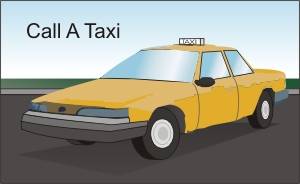 Taxi, Friend, Family Member - If you are drinking outside the home and you find yourself and/or your friends impaired you may want to call a cab, family member or a friend who has not been drinking to come pick you up. Nobody wants a loved one to be in an impaired state, but when they consider the alternatives, a friend or relative will gladly pick you up. Nobody who has been drinking should get behind the wheel!
Taxi, Friend, Family Member - If you are drinking outside the home and you find yourself and/or your friends impaired you may want to call a cab, family member or a friend who has not been drinking to come pick you up. Nobody wants a loved one to be in an impaired state, but when they consider the alternatives, a friend or relative will gladly pick you up. Nobody who has been drinking should get behind the wheel!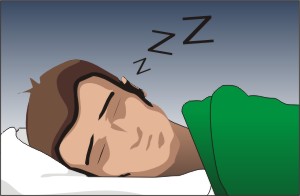 If you are drinking at a friend's home and the suggestion is made that you spend the night, accept the invitation. Sleep on the floor if you have to - wherever you sleep, it will likely be more comfortable than a jail cell.
If you are drinking at a friend's home and the suggestion is made that you spend the night, accept the invitation. Sleep on the floor if you have to - wherever you sleep, it will likely be more comfortable than a jail cell.- Try limiting your drinks. Drink bottled water or juice in between. Spacing out your drinks will reduce your BAC. Also, stop drinking several hours before you need to drive. Remember, only time eliminates the effects of alcohol.
- Our recommendation is DO NOT DRINK AND DRIVE!
1 NHTSA Traffic Safety Facts 2016 - 2016 - Alcohol-Impaired-Driving https://crashstats.nhtsa.dot.gov/Api/Public/ViewPublication/812450
2 NHTSA Traffic Safety Facts 2016 - Motorcycles https://crashstats.nhtsa.dot.gov/Api/Public/ViewPublication/812492
3 NHTSA Traffic Safety Facts 2016 - Pedestrians https://crashstats.nhtsa.dot.gov/Api/Public/ViewPublication/812493
4 Florida Drivers Handbook
5 NHTSA Traffic Safety Facts 2016 - State Alcohol-Impaired-Driving Estimates https://crashstats.nhtsa.dot.gov/Api/Public/ViewPublication/812483
6. Safety Equipment
- Safety belts - Proper positioning, adjustment and drivers' legal responsibilities
- Head rests - Proper positioning and adjustment
- Child restraints - Proper positioning, adjustment and drivers' legal responsibilities
- Airbags including special precautions regarding children and small adults
- Importance of vehicle maintenance
6. 1. Safety belts - Proper positioning, adjustment and drivers' legal responsibilities
We have all heard of the elderly lady who lived in a small apartment and died of starvation. When the police went to investigate, they found over $10,000 in cash. She starved to death, yet she had the resources available to survive within her reach. What do you call someone like that?
The same can be said of a person who dies in a car crash because she or he refused to wear a seat belt. What do you call someone who dies when survival is within his or her reach? What is even worse is when someone does not put his or her child in a proper safety seat.
Lap/Shoulder Safety Belts
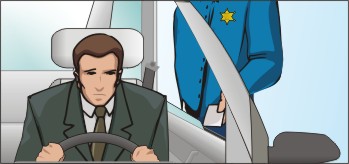
Florida's Law is "Click it, or Ticket!!"
Buckle Up - It's the Law!!!
Florida now has a primary enforcement seat belt law, meaning drivers can be ticketed for not using their seat belts even if there is no other traffic offense.
The first mandatory belt use law was enacted in the State of New York in 1984. Adult belt use laws are now in effect in 49 States and the District of Columbia. The laws differ from state to state, according to the type and age of the vehicle, occupant seating position, etc.
Research has found that lap/shoulder safety belts, when used, reduce the risk of fatal injury to front-seat passenger car occupants by 45 percent and the risk of moderate-to-critical injury by 50 percent. For light truck occupants, safety belts reduce the risk of fatal injury by 60 percent and moderate-to-critical injury by 65 percent.
In 2016, 23,714 occupants of passenger vehicles (cars, light trucks, vans, and SUVs) were killed in motor vehicle traffic crashes. This represents 63 percent of the 37,461 traffic fatalities reported for the year.
Among passenger vehicle occupants over 5 years old, safety belts saved an estimated 14,668 lives in 2016.
Ejection from the vehicle is one of the most injurious events that can happen to a person in a crash. In fatal crashes in 2016, 81% of passenger car occupants who were totally ejected from the vehicle were killed. Safety belts are effective in preventing total ejections. Only 1% of occupants reported to have been using restraints were totally ejected, compared with 29% of the unrestrained occupants.1 The facts speak for themselves. Whether you are going twenty miles per hour or seventy miles per hour, you are a lot better off wearing your safety belt.
The 1996 NHTSA study, Crash Outcome Data Evaluation System (CODES), linked traffic and medical records in seven states to assess total costs of injury from motor vehicle crashes. The study found that the average inpatient costs for crash victims who were not using safety belts were 55 percent higher than for those who were belted (most current data available).
Proper Positioning and Adjustments of Safety Belts
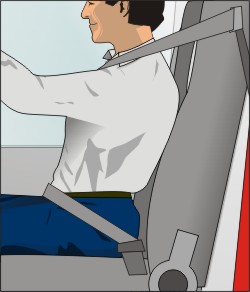
Wear lap belts around your hips, not your stomach. Fasten them snugly. Wear a shoulder belt only with a lap belt.
Florida now has a primary enforcement seat belt law, meaning drivers can be ticketed for not using their seat belts even if there is no other traffic offense.
Any violation of these laws is considered a non-moving violation that carries a fine.
6. 2. Head rests - Proper positioning and adjustment
According to the Insurance Institute for Highway Safety, whiplash injuries in the US due to front or rear crashes cost more than 8.8 billion dollars a year. It is no wonder that insurance companies have an active interest in the quality of headrests that are being installed and utilized in motor vehicles today.
In 1995 it was nearly impossible to find an effective headrest. European car companies led the charge in providing quality adjustable headrests for the consumer.
A headrest is only effective if it is positioned properly. Most front and rear crashes cause the head to twist on the neck. This snapping action is what causes whiplash. The best way to prevent that from happening is to have a headrest adjusted so that the point of contact between your head and the headrest is right where the device meets the base of the skull (where the skull meets the top of the neck). Another good rule of thumb is that the point of contact should be no lower than the ears.
The position of your seat has a lot to do with the effectiveness of the headrest as well. The distance between the headrest and the back of your head should be as little as possible. If your car seat is reclined so low that it resembles the recliner in your living room instead of a driver seat, the headrest will do you little good because this distance defeats the purpose of the headrest.
6. 3. Child restraints - Proper positioning, adjustment and drivers' legal responsibilities
In 2016 in the US, there were 826 children killed in passenger vehicle crashes. Of the 758 fatalities in this age group for which restraint use was known, 289 (38%) were unrestrained.
Among children under 5 years old, an estimated 328 lives were saved in 2016 by child restraint use. Of these 328 lives saved, 313 were associated with the use of child safety seats and 15 with the use of adult belts.
Research on the effectiveness of child safety seats has found them to reduce fatal injury by 71 percent for infants (less than 1 year old) and by 54 percent for toddlers (1-4 years old) in passenger cars. For infants and toddlers in light trucks, the corresponding reductions are 58 percent and 59 percent, respectively.
If 100 percent of motor vehicle occupants under 5 years old were protected by child safety seats, an estimated 370 lives (that is, an additional 42) could have been saved in 2016.1
Failure to read the child safety seat installation instructions and/or vehicle owner manual instructions regarding safety belts could result in serious injury or death as a result of a failure of the child safety seat to be securely and/or properly installed.2

Put your child in a child restraint seat!
It's the Law!!!
The law:
According to F.S.316.613 it is illegal to transport children without the proper safety restraints. It is a moving violation that carries a penalty of three points on your license in addition to paying court costs and a fine, which could amount to more than $100, depending on the court.
The legal guidelines for child restraints are as follows:
- Children three and under must be secured by a federally approved separated or integrated child seat.
- Children four to five years old must be secured by a separate carrier, an integrated child seat, or a child booster seat.
Here are some guidelines that will help in insuring your child's safety:
- Infant car seats must face the rear of the vehicle until the child is one year old and weighs at least 20 pounds.
- Make sure that the shoulder harness is over the shoulder, and make sure that it is snug and that all of the straps are tight.
- If you use an auto booster seat, always use it with the following:
- Lap and shoulder belt
- Tethered harness with lap belt
- Shield with safety belt
- Tether strap (if required)
- The position of the seat needs to be in the middle of the back seat, secured to the seat with seat belts.
- Regardless of age limits set by various state laws, because seat belts may not fit properly on a child's small frame, the Insurance Institute for Highway Safety recommends that kids too big for child restraints should use belt-positioning booster seats until adult belts fit right. For some kids, that's not until age 12. 3
- To protect the child, the safety device used must have a label saying that it meets federal motor safety standards. It must be used correctly, with the child fastened into the car seat and the device fastened to the car. The child should ride in a place where an adult can always be watching (mirrors can be purchased so a child facing the rear can be watched).
- Make sure the seat belt is in the correct position.
- Insist that all children buckle their safety belts before starting the engine.
- Do not hold any child in your arms while riding in a moving motor vehicle. In that position, neither you nor the child you are holding is even remotely safe. As a matter of fact, that is the worst position for your child to be in; the child should be seated in a federally approved booster seat or car seat appropriate for her or his age.
- It is the driver's responsibility to ensure that all children are correctly restrained in a proper booster, car seat or federally approved restraint device. If a child is not restrained properly, the driver will get the citation. Please consider the consequences if your child is not placed in a secured, approved safety device and you slam on your brakes. Your child becomes a tiny human projectile.
- It is unlawful for any person to operate a motor vehicle in the state of Florida unless each passenger of the vehicle under the age of eighteen years is restrained by a safety belt or a child restraint device in compliance with F. S. 316.613 and F.S. 316.614.
6. 4. Airbags including special precautions regarding children and small adults
Airbags, combined with lap/shoulder safety belts, offer the most effective safety protection available today for passenger vehicle occupants. In 2016, an estimated 2,756 lives were saved by air bags. From 1987 to 2016, a total of 47,648 lives were saved.1

Air bags are supplemental protection and are not designed to deploy in all crashes. Most are designed to inflate in a moderate-to-severe frontal crash. For this and other reasons, lap/shoulder belts should always be used, even in a vehicle with an airbag.
Children in rear-facing child seats should not be placed in the front seat of vehicles equipped with passenger-side air bags. The impact of a deploying air bag striking a rear-facing child seat could result in severe injury or death. The NHTSA also recommends that children 12 and under sit in the rear seat away from the force of a deploying airbag.
It is recommended that small adults and the elderly practice extra precautions as well. The force of an airbag could have a severe impact on these individuals. To prevent any unnecessary injuries, have the individual position their seat as far back as possible to lessen the impact of a deploying airbag.
Helmets
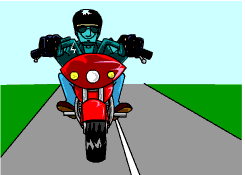
NHTSA estimates that helmets saved the lives of 1,859 motorcyclists in 2016 in the US. If all motorcyclists had worn helmets, an additional 80 lives could have been saved. Helmets are estimated to be 37 percent effective in preventing fatal injuries to motorcyclists. Reported helmet use rates for fatally injured motorcyclists in 2016 were 60 percent for operators and 44 percent for passengers. 4
OCCUPANT PROTECTION DEVICES
Automakers include the following safety devices to make sure your vehicle is as safe as it can be:
HEAD RESTRAINTS:
Adjusted to the middle of the head, level with the ears, it protects the neck from whiplash.
DOOR LOCKS:
Lock all doors. Door locks provide better protection in a collision, preventing occupants from being ejected.
COLLAPSIBLE STEERING COLUMNS:
The steering column collapses in a collision so that a driver's chest is protected from injury. The steering column absorbs some of the impact forces in a collision.
PADDED DASHBOARDS:
Designed to cushion the occupant if the occupant comes in contact with the dashboard.
REARVIEW MIRROR:
Rearview mirrors are glued on the windshield, not bolted to the frame of vehicle. If the occupant comes in contact with the mirror, the injury is less severe.
RECESSED KNOBS ON THE PANEL:
Vehicle designs try to eliminate any sharp or protruding knobs such as heater controls, radio knobs, and windshield wiper switches.
RECESSED DOOR HANDLES:
Designed to be somewhat recessed and smooth to prevent injury if contact is made to handles by occupants.6
6. 5. Importance of vehicle maintenance
It has been said if you take care of your vehicle, it will take care of you. This is certainly true. Safe driving depends on having your vehicle's systems in good working order. Maintenance should be a daily habit. Check your mirrors and watch your lights and gauges, and if they indicate a problem, fix it or take it to someone who will fix it for you.
But there is much more to vehicle maintenance. There are procedures that you need to take care of at regular intervals. Your owner's manual is the best source of information on scheduled maintenance. It lists the equipment that needs to be checked and when this maintenance should take place. Some of the procedures are easy enough for you to do yourself. Others should be done by a trained mechanic. Once you know what they are and when they need to be done, it is up to you to arrange for maintenance - don't wait for a breakdown to learn that something is wrong with your vehicle.
Here are some of the tasks that need to be completed, along with any others suggested in your owner's manual:
Engine, Power Train, and Ignition Systems:
Tune the engine, change the transmission fluid, check the clutch pedal travel and adjust as necessary, and lubricate parts of the power train.
Fuel and Exhaust Systems (Carbon Monoxide Poisoning):
Check the fuel lines for leaks, replace the fuel filter, replace the air filter, clean the carburetor, check the performance of the emission control system, and check the exhaust pipe and muffler for leaks.
Checking the exhaust pipe and muffler for leaks is critically important, especially if you can smell exhaust fumes in your vehicle. An exhaust system that leaks fumes into the vehicle can lead to carbon monoxide poisoning.
Symptoms of carbon monoxide poisoning include; headache, dizziness, weakness, nausea, vomiting, chest pain, and confusion. If you suddenly feel any of these symptoms while driving, get out of the vehicle immediately and call for help. Carbon monoxide poisoning is very difficult to diagnose because its symptoms often mimic those of other diseases.
Steering and Suspension Systems:
Grease the steering linkage, align the front wheels, grease the wheel bearings, and check the condition of the springs and shock absorbers.
Brakes:
Good brakes are an essential safety component in any motor vehicle. How long brakes last and how they perform depends on how you use and maintain them. If a leak develops in the brake system, you may experience total or partial brake failure, thus increasing your stopping distance. Steering may also become difficult. The braking system must be checked immediately and repaired. NEVER drive a vehicle with a faulty braking system, regardless of the distance. Maintenance requires that you:
Check the master cylinder and brake lines for leaks, check the brake linings and drums (or pads and discs), and check the operation of the parking brake.
Lights:
Headlights, taillights, brake lights, and turn signal lights can burn out. Check them by watching their reflection on a wall or a garage door. You may also ask someone to help you. Defective lights make your vehicle hard to see.
Keep your headlights aimed properly. Headlights aimed too high can temporarily blind an oncoming driver. Headlights aimed too low reduce your sight distance at night or during low-visibility conditions.
Lubrication and Cooling Systems:

Lubrication is the use of oil and grease to reduce friction in a vehicle's moving parts. Lubrication prevents damage from heat and friction and keeps the moving parts operating efficiently. Drain the engine oil and replace it with fresh oil, change the oil filter (whenever the oil is changed), and change the coolant in your radiator at regular intervals.
Tires:
Tires are very important in having a safe trip. Remember that only a small portion of the tire is used to make the vehicle stop and turn. It is your only contact with the road. It is important to maintain proper air pressure. Too little air even in one tire can make a vehicle difficult to control. Tread on a tire helps to keep traction, which means control and the ability to stop on a wet surface.
You can extend the life of your tires by avoiding fast starts, stops and turns. Check the tires periodically and rotate them regularly. Look for weak spots, cuts, blisters, rocks caught in the tread, and uneven wear. Replace tires before they become unsafe.
1 NHTSA Traffic Safety Facts 2016 - Occupant Protection https://crashstats.nhtsa.dot.gov/Api/Public/ViewPublication/812494
2 NHTSA Traffic Safety Facts 2016 - Children https://crashstats.nhtsa.dot.gov/Api/Public/ViewPublication/812491
3 Insurance Institute for Highway Safety - Keeping Children Safe In and Around Cars
4 NHTSA Traffic Safety Facts 2016 - Motorcycles https://crashstats.nhtsa.dot.gov/Api/Public/ViewPublication/812492
7. Psychological Factors
- Dealing with stress
- Dealing with fatigue
- Dealing with emotional distress
- Appropriate attitude
7. 1. Dealing with stress
Stress is the reaction of our bodies and minds to anything that upsets the regular balance. Stress can occur when good things as well as bad things occur. External events and situations that are painful typically cause stress, which leaves you feeling out of control. Pushing your body too hard at work or at play will soon deplete your body of the energy it needs to restore itself and result in you becoming stressed. Often people feel the effects of emotional disorders such as anxiety and sleep disturbances.
Aggressive driving by yourself or others can lead to stress. Eliminating stress from your life is impossible; however, implementing some stress management techniques can subdue some of its harmful effects. The many ways to keep the negative effects of different stresses to a minimum include:
- Take time to relax each day.
- Learn to "let go" of things that are outside your control.
- Learn to adapt to change.
- Learn to take action when you can make a difference.
- Give your time to something or someone you believe in.
7. 2. Dealing with fatigue

Sleep is a neurobiological need with predictable sleepiness and wakefulness.
The loss of one night's sleep can lead to extreme-term sleepiness, while habitually restricting sleep by 1 to 2 hours a night can lead to chronic sleepiness. Sleeping is the only way to reduce sleepiness. Sleepiness causes auto crashes because it impairs performance and it can ultimately lead to the inability to resist falling asleep at the wheel. Critical aspects of driving impairment associated with sleepiness are reaction time, vigilance, attention and information processing.
Subjective and objective tools are available to approximate or detect sleepiness. However, unlike the situation with alcohol-related crashes, no blood, breath or other measurable test is currently available to quantify level of sleepiness at the crash site. Although current understanding largely comes from inferential evidence, a typical crash related to sleepiness has the following characteristics:
- The problem occurs during late night/early morning or late afternoon.
- The crash is likely to be serious.
- The crash involves a single vehicle on the roadway.
- The crash occurs on a high-speed road.
- The driver does not attempt to avoid the crash.
- The driver is alone in the vehicle.
Although evidence is limited or inferential, certain chronic, predisposing factors and acute situational factors are recognized as increasing the risk of drowsy driving and related crashes. These factors include:
- Sleep loss.
- Driving patterns, including driving between midnight and 6 a.m.
- Driving a substantial number of miles each year and/or a substantial number of hours each day.
- Driving in the late afternoon hours and driving for longer times without taking a break.
- Use of sedating medications, especially prescribed anxiolytic, tricyclic antidepressants and some antihistamines.
- Consumption of alcohol, which interacts with and adds to drowsiness.2
Helpful behaviors include:
- Plan to get sufficient sleep.
- Do not drink even small amounts of alcohol when sleepy.
- As soon as you become sleepy, stop.
- Trade driving shifts with a passenger.
How to Deal with Fatigue:
- Listen to upbeat music.
- If you have passengers, have one stay awake to talk.
- Stop for short breaks in a safe area every two hours. Take a brisk walk, breathe deeply, and eat a small snack. You may want to take a short (15-20 minute) nap. If you have trouble waking up from your nap, find a safe place to sleep.
- Don't take chances with your safety, your passengers' safety, and the safety of all other road users. If you become sleepy while driving, pull off the road and get some sleep.
- Consume caffeine. The equivalent of two cups of coffee can increase alertness for several hours.3
7. 3. Dealing with emotional distress
Emotion is a word used to identify a strong feeling such as anger, fear and joy. Emotions influence the way you think and act. When emotions affect your thoughts and actions, they can change the way you normally assess risk and make driving decisions.
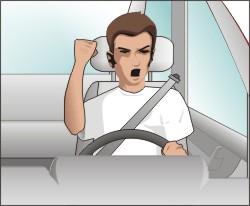
Strong emotions can interfere with your ability to think and reason. When strong emotions affect you, your ability to make wise decisions is reduced and your chances of making a mistake increase. This may be a reason for road rage. The effect that an emotion has on your ability to drive depends upon the strength of the emotion and the effort that you make to resist its effects. Emotions can affect the way you judge the risks involved in a driving situation. A strong emotion can cause you to fix your attention on one event , causing you to miss another important event in the driving situation. One emotion could lead to another, resulting in you experiencing several strong emotions in a short period of time.
Strong emotions can also cause changes in your bodily functions. Your body prepares itself for stressful events by making your heart pump faster and your palms become sweaty. You can expect some emotional stress in your everyday driving.
If you are angry or excited, give yourself time to cool off. If necessary take a short walk, but stay off the road until you have calmed down.
If you are worried, depressed or upset about something, try to keep your mind on your driving. Try to find something to listen to on the radio. Don't become impatient with a slower driver ahead of you.
Emotions influence the way you think and act. When emotions affect your thoughts and actions, they can change the way you normally assess risk and make driving decisions.
When strong emotions affect you, your ability to make wise decisions is reduced. Your chances of making a mistake increase.
If you are impatient, give yourself extra time for your driving trip. Leave a few minutes early. If you have plenty of time, you tend not to speed or do other things that can get you a traffic ticket or cause a crash.
Don't be impatient if a train crosses in front of you. Wait instead. Driving around lowered gates or trying to beat the train can be fatal.
DEALING WITH DISTRACTIONS
There are many distracting factors that compete for the driver's attention. It is important that good habits be developed so there can be safe movement through a traffic situation. Distraction from the driving task can be caused by:
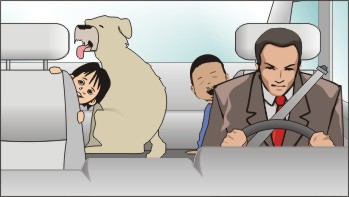
- Thinking of things other than driving.
- Talking on a cell phone.
- Having "distracters" which require the driver's attention in the vehicle.
- Situations outside the vehicle that attract the operator's attention.
- Environmental factors.
- Vehicle factors.
- Route problems in unfamiliar areas.
- Seeing one potential collision hazard in the traffic scene while failing to see another.2
How to Deal with Distraction:
- Minimize the need to adjust controls while driving by taking a few moments to prepare for your trip when you enter your vehicle.
- Avoid personal grooming, such as shaving, applying make-up, or combing hair, while driving.
- Never read while driving. This includes maps, directions, text messages, books and newspapers.
- Avoid eating in your vehicle. Most foods are too messy to eat while driving.
- Ask your passengers to keep their voices low during your trip. Don't conduct emotional discussions while driving.
- Avoid reaching for things inside your vehicle. Taking your eyes off the road, even for a few seconds, could result in a crash.
- Avoid becoming distracted by people or things outside your vehicle. Focus your attention on scanning for potential hazards.
- Make a commitment to keep your mind on your driving and implement safeguards so you'll keep your commitment. If you are often tempted to use a cell phone while driving, for example, store the phone in the trunk of the vehicle.
Remember, as a driver, your only task when you enter your vehicle is to arrive safely at your destination. Anything else can be taken care of when you arrive.
7. 4. Appropriate attitude
CHOICES HAVE CONSEQUENCES
Safe driving involves both mental and physical exercise. If we are to be safe on our highways, we need to address both. First, let's look at mental exercise. Attitude is the way we look at a situation and how it affects us.

What effect did getting a ticket have on you? Are you angry? If you are, at whom? Perhaps you are even seeking to place the blame on someone else or trying to make some excuse for your actions. If you think receiving a ticket was unjust or unfair, a court of law will make that decision. However, you have chosen this driver improvement course as a way to resolve this action. Now assume your place of responsibility and go forward. Assume a safe driver attitude. Obeying the law is the right and fair thing to do. It helps you to treat others the way you want to be treated. Let us be fair to ourselves, our family, and fellow travelers on our highway. Do you expect others to obey the law? Of course you do. Why then should another not expect the same of us?
Ultimately, we are in charge of our attitudes.
Responsibiility
The purpose of this exercise is to determine the responsibility of Mr. Driver. Did you notice that the heading on this section is spelled incorrectly? Did you notice the extra "i"? This was done intentionally to prove a point, which is that most of us have taken the "I" out of responsibility. This happens when the objective is to find the closest person or circumstances to pass the buck to so we can be excused. Taking the "I" out of responsibility in our driving can lead to serious problems, such as crashes that result in injury or death. We need to be aware of when our responsibility, along with courtesy and common sense, has been dismissed for the sake of convenience. The best way to prevent a problem is to correct an attitude. Let's look at an example. Anytown Elementary School is on the west side of a two-lane road with 12-foot lanes separated by a broken yellow line. The school, complete with parking lot, is surrounded by an open field on its side of the road, and woods on the opposite side. One thousand feet south of the school on the other side of the road is a sign with a blinking light. The sign indicates that the area in question is a school zone with a speed limit of 20 miles per hour when the light is blinking. Two girls are walking south, away from the school, on the sidewalk on the west side of the road. A boy is running after them. The distance from the sidewalk to the school is 50 feet. Across from the school, a blue car is parked on the shoulder of the road, directly in front of a "No Parking" sign. A red car is stopped in the northbound lane, with skid marks leading up to the car. The skid marks indicate that the car was moving at 20 mph when the driver slammed on the brakes. A girl's body is lying in front of the red car (not shown on the diagram).

School Zone hours: 2:00 pm - 3:00 pm
School Dismisses: 2:30 pm
Crash Occurs: 2:35 pm
Mrs. Ima Mother vs. Mr. Jay Walker Driver
How much is Mr. Driver responsible?
100% 75% 50% 25% 0%
Mrs. Mother's Statement
"This happened on Mary's 11th birthday. We had planned a birthday party at the local water park. We live about 18 miles from the school. It takes about an hour and a half for Mary to get home by riding the school bus. If she had to ride the bus, then we would have to travel about 45 minutes to get back to the water park. We could save a lot of fun time if I just picked her up from school. That morning, I took Mary to the school and parked across the street in front of the school. The parking lot is a very dangerous place, since all of the vehicles must use it, like the buses, teachers, parents, and the like. Besides, if I stopped out front I could watch her go into the school. As I dropped Mary off, I gave her a note for her teacher telling her about our plans, and to call me if there was a problem. As Mary got out of the car, I told her not to run and to look both ways before she crossed the street. She did look both ways and she did not run. I saw her go into the school. Since I didn't hear from the teacher all day, I assumed I could pick her up as planned. I arrived at the school around 2:35 pm, after stopping to get ice for the party. As I stopped, I saw Mary standing just outside of the door of the school. We waved and she started walking toward the car. After watching her for a few seconds, I looked to see if there was any traffic coming. There was a car heading in our direction, but it did not look like it was going very fast. I watched it for a few seconds and then turned back to Mary. She was running by that time, so I again glanced at the car. It was much closer now. Several things ran through my mind. I decided in a moment to blow the horn, but before I could, I heard the squealing of tires and a thud. I looked, saw the car now stopped, and saw Mary, lifeless on the pavement."
Mr. Driver's Statement
"I am familiar with the school zone, as I go through the area several times a week on my way home. I know what time school lets out and when there are children on the road. Today, I got off work early and was on my way home. Since it was a nice day, I decided to mow the yard. As I came to the school zone I slowed to the 20 mph limit. There were some children on the sidewalk coming toward me, and I could see a blue car on the east side of the road in front of the "No Parking" sign. I looked over at a boy running toward a couple of girls walking down the sidewalk. As I looked to the road again, I saw a little girl run out ahead of me. I slammed on the brakes, but could not stop in time. Everything in my car is in good working order and I was feeling fine up until the crash."
In your opinion, by expressing in percentage:
WHAT IS THE DRIVER'S RESPONSIBILITY?
WHAT IS THE MOTHER'S RESPONSIBILITY?
WHAT IS THE CHILD'S RESPONSIBILITY?
Mother's Responsibility - 100%?
- The Mother was illegally parked both in the morning and in the afternoon. Both times, she should have been in the parking lot.
- The Mother arrived at the school after classes had been dismissed. Not only did this take away the Mother's opportunity to cross the road with her child, but it increased the likelihood of the child becoming impatient and running instead of walking.
- The Mother was aware of the vehicle while it was still at a distance, and failed to warn the child of it until it was too late.
Child's Responsibility - 100%?
- The child should have followed her mother's instructions to walk and not run.
- The child should have been aware of the approaching vehicle.
Driver's Responsibility - 100%?
- Seeing the first two girls should have slowed the driver down. Always plan for children to do the unexpected.
- Seeing the running boy should have put the driver on full alert. The boy may have run into the street himself or caused the girls to run into the street.
- Seeing that the children were on the sidewalk, he should have deduced that school was out. Also, seeing an improperly parked car, he should have prepared himself for the eventuality that a child could run to or from the car or that the car could pull out in front of him.
How Much Are We Responsible? 100%?
- In most crashes with two or more drivers, we both contribute. It is possible that we do not contribute equal amounts, but we are both responsible. One or both may or may not have violated the law. Contributing to a crash and violating the law may be two different things.
- Just because one party commits an unsafe act does not mean we are not responsible for our own actions in an attempt to avoid the collision.
- We are responsible to have our vehicles under control at all times.
- If someone runs a red light in front of us, we are not justified in striking them.
- In a way, we are our brother's (and our sister's) keepers.
Responsibility is not a pie that can be sliced up, with a portion for each. Responsibility is like air: There's more than enough for each of the characters - the mother, the daughter, and the driver each could have prevented this tragedy from occurring regardless of the behavior of the other characters.
Florida Statute 316.183 (1) states that "No person shall drive a vehicle on a highway at a speed greater than is reasonable and prudent under the conditions and having regard to the actual and potential hazards then existing. In every event, speed shall be controlled as may be necessary to avoid colliding with any person, vehicle, or other conveyance or object on or entering the highway in compliance with legal requirements and the duty of all persons to use due care."
As we drive, we must be able to identify possible problems ahead of us. The law calls for us to drive having regard for the actual and potential hazards in existence.
What were some of the potential hazards in the school demonstration?
- School zone, with a reduction in the lawful speed limit.
- Children walking on the sidewalk.
- A child running on the sidewalk.
- A car parked in the "No Parking Zone."
- A person sitting in a parked car.
- A parking lot with vehicles entering and exiting.
- Possibility of unseen events - for example, a child petting a dog in front of a parked car.
Speed Adjustments
The fact that the speed of a vehicle is lower than the prescribed limits shall not relieve the driver from the duty to decrease speed when approaching and crossing an intersection. When approaching and going around a curve, when approaching a hill crest, when traveling upon any narrow or winding roadway, when special hazards exist or may exist with respect to pedestrians, other traffic, or by reason of weather or other roadway conditions. The speed shall be decreased as may be necessary to avoid colliding with any person, vehicle or other conveyance on or entering the street in compliance with legal requirements and the duty of all persons to use due care.

Speeding was a factor in 27 percent of all fatal crashes, and 10,111 lives were lost in speeding-related crashes in 2016.4 Speed is important because if a crash occurs, the forces involved in the crash increase exponentially as speed increases. Ask yourself, "Why do I speed?" Some typical answers are: late for work, late getting home, late for an appointment or even no reason at all! We are trying to turn the clock back. Before we speed, we should ask ourselves, "What will I gain by speeding? Am I trying to save time?" Let's take a look at that for a minute. You have a twenty-mile trip to make. If you drive at the speed limit, which is 55 miles per hour, it will take you approximately 21 minutes and 48 seconds. However, let's assume you are late, so you have decided you are going to travel at 75 miles per hour, which will take approximately 15 minutes and 59 seconds. That is a saving of five minutes and 49 seconds.
Let's say you are stopped by a highway patrolman and it takes him 10 minutes to write the ticket. You'll also spend time to, complete this course (4 hours). And what happens if another vehicle stops in front of you and you are going too fast to stop or something happens to your car? You really are going to be late and who knows - the death rate in Florida may go up one more number. We didn't even mention the money you spent on your citation ; paying for this course, and the money you lost by being late for work. If you had the money back that you spent for this ticket, what would you do with it?
Staying out of dangerous situations while you are driving is a full-time job. The time that you spend traveling on our highways is not time to be talking on the phone, combing your hair, shaving, or having breakfast. Have you ever had a cup of coffee in one hand and a sausage biscuit in the other while you were driving with only your knee? That is a prime example of doing too much and putting yourself and others at risk.
1 NHTSA - Drowsy Driving https://www.nhtsa.gov/risky-driving/drowsy-driving
2 NHTSA - Drowsy Driving and Automobile Crashes http://www.nhtsa.gov/people/injury/drowsy_driving1/drowsy.html
3 NHTSA Traffic Safety Facts 2016 - Speeding https://crashstats.nhtsa.dot.gov/Api/Public/ViewPublication/812480
8. Florida Traffic Laws
- Progressive severity of legal actions including the point system and licensing actions (cancellation, suspension and revocation)
- Speed limits including default limits where not posted
- Signs, signals, road markings, interpretation of centerlines, crosswalks, bike lanes, turn lanes, flashing lights and proper responses to phases of traffic signals, stop signs and yield signs
- School buses including laws on passing while stopped
- Proper response to emergency vehicles
- Required vehicle safety equipment
8. 1. Progressive severity of legal actions including the point system and licensing actions (cancellation, suspension and revocation)
DRIVERS' LICENSES
The Department of Highway Safety and Motor Vehicle is charged with the administration and enforcement of the provisions of this chapter.
The Division of Driver License shall make and adopt rules and regulations for orderly administration of this chapter. The Division determines how an individual gets a driver license, and who will not get a license and why.
Driving a motor vehicle in Florida is a privilege you earn. Every driver who gets a license must drive safely to keep it. If you break the traffic laws or become an unsafe driver, your license can be taken away. It can be suspended, revoked or canceled.
Suspension
You can get your driver license suspended for a variety of reasons. The suspensions vary in length. They are as follows:
- Violation of the point system - The point system is the method of assigning points for certain traffic infractions. The points vary depending on the severity of the traffic offense. In computing points and suspensions, the offense dates of all convictions are used.
They are as follows:
| Traffic infraction | Violation points |
|---|---|
| Leaving the scene of a crash resulting in property damage of more than $50. | 6 |
| Unlawful speed resulting in a crash | 6 |
| Reckless driving | 4 |
| Any moving violation resulting in a crash | 4 |
| Passing a stopped school bus | 4 |
| Driving during restricted hours | 3 |
| Unlawful speed 16 MPH or more over the speed limit | 4 |
| Violation of a traffic control signal/sign/device (if camera-enforced, no points will be assessed) | 4 |
| Unlawful speed 15 MPH or less over the speed limit | 3 |
| (Fines are doubled when infractions occur within a school zone or construction zone, with possible civil penalties up to $1,000, and the offender may be required to complete a driving school course.) | |
| All other moving violations | 3 |
| Parking on a highway outside the city limits | 3 |
| Open container as an operator | 3 |
| Child restraint violation | 3 |
| Length of Suspension | |
| 12 points within a 12-month period | 30 Days |
| 18 points within an 18-month period | 3 months |
| 24 points within a 36-month period | 1 Year |
You may apply for a hardship license if you participate in the 12-hour ADI (Advanced Driving Improvement) class, pay a $25 reinstatement fee and pay all applicable licensing fees.
- Fail to pay child support. A $25 reinstatement fee will be required.
- Did not attend court ordered traffic school - If you do not attend a court ordered class you must contact the court where it was ordered, satisfy the traffic summons, show proof of satisfaction and pay a $25 reinstatement fee. You may attend traffic school once per year.
- Incapable of operating a motor vehicle - This comes with a one year suspension and you are not eligible for a hardship license. In order to get your license back at the end of one year, you must request a hearing for the purpose of reinstatement.
- Refusal to take a field sobriety test - You have the right to refuse a field sobriety test; however, you will automatically incur a one year suspension.
- Truancy - If you are under age 18, your license can be suspended for truancy and it will remain suspended until you provide proof of school attendance for 30 consecutive days.
- Fail to carry insurance on your vehicle - If your driver license or license plate(s) are suspended for not obeying Florida insurance laws, you cannot get a temporary license for any reason, not even for work purposes only.
- Break a traffic law and fail to pay your fine or appear in court as directed.
Revocation
When your license is revoked, it is taken away for a period of six months to life. Revocation can occur for a variety of reasons, including:
- Vision worse than the standard minimum requirements.
- Killing someone because of reckless driving.
- A felony for drug possession.
- A felony in which a motor vehicle was used.
- Not stopping to give help when the vehicle you are driving is involved in a crash causing death or personal injury.
- Commit a lewd act or involved in an act of prostitution in a motor vehicle.
- Commit an act of perjury in a court of law.
- Conviction of a crime in another state.
- A court may also order that your license be revoked for certain traffic offenses.
- Your license can be revoked for certain medical conditions. The revocation lasts as long as the medical condition exists and can be removed when the medical condition clears.
Cancellation
When a driver's license is canceled, it is declared void and terminated. This happens when you fail to meet requirements established by Florida state statute.
Some of the reasons for cancellation are as follows:
- Fraudulently misrepresenting information on a driver license application. (The driving privilege will also be suspended for one year.)
- Failure to maintain a court-ordered requirement.
- Failed to maintain a DUI issue.
- You are responsible for a crash where somebody goes to the hospital and you fail to go to the required four-hour traffic school course.
Disqualification
Disqualification is an administrative procedure that applies primarily to holders of commercial driver licenses. The disqualification can be either temporary or permanent for reasons such as;- Medical disqualification.
- Conviction of driving with a BAC of .04.
- Refusal to submit to a test for the presence of drugs or alcohol.
Holders of a temporarily disqualified commercial driver license, who are otherwise qualified, may swap their commercial driver license for a regular Class E operator's license for the period of their disqualification.
If you are caught driving while your license is suspended, revoked, cancelled, or disqualified, the degree of crime is as follows:
- First offense - Misdemeanor of the second degree.
- Second offense - Misdemeanor of the first degree.
- Third offense - Felony of the third degree.
Habitual Traffic Offender
A habitual traffic offender is an individual whose record shows that they are a danger to the motor vehicle community by continually displaying a complete disregard for their safety or the safety of fellow motorists that are sharing the road.
Individuals become designated as habitual offenders by accumulating three or more of any of the following convictions within a five-year period:
- Voluntary or involuntary manslaughter resulting from the operation of a motor vehicle.
- Driving under the influence.
- Any felony in which a motor vehicle is used.
- Driving a motor vehicle while the driver license is suspended or revoked.
- Failing to stop and help as required under the laws of this state in the event of a motor vehicle crash resulting in the death or personal injury of another.
- Driving a commercial vehicle while the driver privilege is disqualified.
If an individual accumulates 15 convictions for moving traffic offenses for which points may be assessed within a five-year period, they may also qualify for habitual traffic offender status.
The penalty for a person who has earned this title is a five-year revocation. The legal ramifications pale in comparison to the life-altering anguish that you will go through to get to this point in your life. Your car insurance will be so high that it will be unrealistic for a person with average means to maintain a driver's license. This will affect your employment and personal life as well. Picking up a date on your bicycle or asking your date to take the bus is not exactly the most impressive way to kick off a date. In short, being a habitual traffic offender will make your life miserable.
8. 2. Speed limits including default limits where not posted

If it walks like a duck, quacks like a duck, looks like a duck, then it must be a duck. Call it what you want to: "unlawful speed", "too fast for conditions", "failure to use due care", "failure to have your vehicle under control", or "speed greater than is reasonable and prudent", but too fast is too fast. You may blame whomever you choose: the police officer, the judge, the weather, your boss, or even your mate for your citation, but it doesn't change the fact that you were speeding.
Let us give you something to think about. Speeding reduces a driver's ability to steer safely around curves on the highway or avoid objects in the roadway. It extends the distance necessary to stop a car, increases the distance a vehicle travels while a driver reacts and reduces the effectiveness of the vehicle's safety features. The faster you go the harder you hit.
There is a big difference between unlawful speed and speed too fast for conditions or failing to have your vehicle under control. Speeding - exceeding the posted speed limit - is one of the most prevalent factors contributing to traffic crashes. In 2016, speeding was a contributing factor in 27 percent of all fatal crashes and 10,111 lives were lost in speeding-related crashes.1 The 2010 costs of speeding-related crashes were estimated to be $52 billion, an average cost of $168 for every person in the U.S. 2
Too few drivers view speeding as an immediate risk to their personal safety or the safety of others. But crash severity increases with the speed of the vehicle at impact. Inversely, the effectiveness of restraint devices like air bags and safety belts, and vehicular construction features such as crumple zones and side member beams, decline as impact speed increases.
The probability of death, disfigurement, or debilitating injury increases with higher speed at impact. Such consequences double for every 10 mph over 50 mph that a vehicle travels.
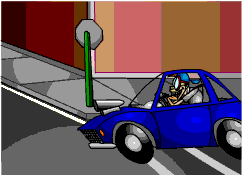
Many drivers don't consider this. They slow their speed in residential areas, or when the weather turns bad. To them, a few miles an hour over the posted speed limit is an acceptable risk. Their excuse - other drivers do it. They believe the worst that can happen to them is to receive a speeding ticket. Drivers like this are wrong. Maybe even dead wrong, because driving too fast for conditions or exceeding the posted speed limit can kill YOU.
For drivers involved in fatal crashes, young males are the most likely to be speeding. The relative proportion of speeding-related crashes to all crashes decreases with increasing driver age. In 2016, 32% of the male drivers 15 to 20 years old who were involved in fatal crashes were speeding at the time of the crash.
Alcohol and speeding seem to go hand in hand. In 2016, 37% of the speeding drivers in the US under 21 years old who were involved in fatal crashes were also impaired, with a blood alcohol concentration (BAC) of 0.08 (grams per deciliter [g/d1]) or greater. In contrast, only 15% of the non-speeding drivers under age 21 involved in fatal crashes in 2016 were impaired.
For drivers between 21 and 24 years of age who were involved in fatal crashes in the US in 2016, 42% of the speeding drivers were impaired with a (BAC) of 0.08, compared with only 20% of non-speeding drivers.
Speeding was a factor in 17% of the fatal crashes that occurred on dry roads in 2016 and 21% of those that occurred on wet roads.
Speeding was involved in 28% of the fatal crashes that occurred in construction/maintenance zones in 2016.
In 2016, 86% of speeding related fatalities in the US occurred on roads that were non-Interstate highways.
For both speeding and non-speeding drivers involved in fatal crashes, the percentage of those who had been drinking, with BAC 0.01 or greater, at the time the crash occurred was higher at night than during the day. Between midnight and 3 am, 60 percent of speeding drivers involved in fatal crashes had been drinking. 1
Speed limit- Default speed limit
The speed limit is posted in most areas and changes with road conditions. If the speed limit is not posted, the default speed limit will be in effect.
Florida Standard Speed Limits
Municipal Speed Areas - 30 mph
Business or Residential Areas - 30 mph
Rural Interstate* - 70 mph
Limited Access Highways - 70 mph
All Other Roads and Highways** - 55 mph
School Zones - 20 mph
**The 55 mph maximum speed limit is still in effect in Florida except where otherwise posted. *Speed limits are 70 mph on some rural interstate highways. Speed limits may be changed on other multi-lane highways and in areas where the conditions require lower speeds. Drivers should not assume that because the area appears to be a particular urban, municipality, business or highway area that the speed is the standard or expected speed zone. Observe and obey the posted speed signs as there may be frequent changes from area to area along the selected roads or highways.
Minimum speed limits: When the maximum speed limit is 70 mph, the minimum speed limit is 50 mph; otherwise, the minimum speed limit is 40 mph.
Speed limit signs are posted at the beginning of a speed zone and drivers must be driving at that speed starting at the location of the posted sign and continuing until there is a posted speed limit change.
Source: S 316.183 to S 316.1895 F.S.
8. 3. Signs, signals, road markings, interpretation of centerlines, crosswalks, bike lanes, turn lanes, flashing lights and proper responses to phases of traffic signals, stop signs and yield signs
Traffic signals control traffic and indicate which drivers may go and which drivers are required to stop. It is important to understand the meaning of each color and symbol. On vertical signals, the red light is on the top, the yellow light is in the middle and the green is on the bottom. When signals are mounted horizontally, the red light is at the left, the yellow is in the middle and the green is to the right. The colors are in the same position on signals throughout the United States. This national uniformity allows even colorblind people to drive safely.
GREEN INDICATION - Vehicular traffic facing a circular green signal may proceed straight through cautiously or turn right or left unless a sign at such place prohibits either such turn. F.S. 316.075 (1)(a)1
GREEN ARROW -- Vehicular traffic facing a green arrow signal, shown alone or in combination with another indication, may cautiously enter the intersection only to make the movement indicated by such arrow, or such other movements as is permitted or other indications shown at the same time. F.S.316.075 (1)(a)2
STEADY YELLOW INDICATION. - Vehicular traffic facing a steady yellow signal is thereby warned that the related green movement is being terminated or that a red indication will be exhibited immediately thereafter when vehicular traffic shall not enter the intersection. F.S. 316.075 (1)(b)1
STEADY RED INDICATION - Vehicular traffic facing a steady red signal shall stop before entering the crosswalk on the near side of the intersection or, if none, then before entering the intersection and shall remain standing until a green indication is shown. F.S. 316.075 (1)(c)1
The driver of the vehicle must stop at the clearly marked stop line, but if none, before entering the crosswalk on the near side of the intersection, or if none, then at the point nearest the intersection roadway where the driver has a view of approaching traffic on the intersecting roadway before entering the intersection. The driver may turn right on red if there is no sign prohibiting it, but shall yield the right-of-way to pedestrians and other traffic proceeding as directed by the signal. F.S. 316.075 (1)(c)(1)(a)
TRAFFIC SIGN COLORS
Traffic signs are designed for easy understanding. They have uniform shapes and colors. Once you know the colors and understand the meaning of the signs, you can quickly recognize the intended message.
SIGN COLOR
Blue -------Services, Guidance. (Hospital)
Brown------Public Recreation, Scenic Places. (State Park)
Green------- Guide signs for direction.
Orange------Construction and maintenance warning.
Red ---------Regulatory signs. Indicate stop or forbidden actions.
White--------General regulatory and speed control.
Yellow ----- General warning signs that caution drivers.
SIGNALS, SIGNS and PAVEMENT MARKINGS
Along with their colors and shapes, signs also display symbols. Signs contain word messages or a combination of words and symbols. You read a word message from left to right, or in a few exceptions, from top to bottom. You read symbols from the bottom up.
Traffic Control Signals
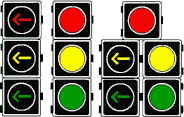
Traffic signals are placed at intersections to keep traffic moving and avoid crashes. Drivers, pedestrians, and bicycle riders must obey these signals except when an officer is directing traffic. Stop on the stop line if your car is nearest the signal. Some signals change only when a car is at the stop line. If traffic signals are out of order, stop as you would for a four-way stop sign.
No Parking
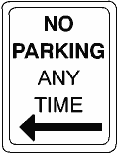
Parking is not allowed:
- On any bridge or overpass or in a tunnel.
- Within 30 feet of a rural mail box on a state highway between 8 am and 6 pm.
- Within 30 feet of any flashing signal, stop sign or traffic signal.
- In such a way that you block or create a hazard for other vehicles.
- Within 50 feet of a railroad crossing.
- On the roadway side of another parked vehicle (double parking).
- In crosswalks.
- On sidewalks.
- In front of driveways.
- By curbs painted yellow or where "No Parking" signs are posted.
- Within intersections.
- Within 15 feet of a fire hydrant.
- Within 20 feet of an intersection.
- Within 20 feet of the entrance to a fire, ambulance or rescue squad station.
- On the hard surface of a highway where parking spaces are not marked.
Parking Lights
Parking lights must be used on any vehicle parked on a roadway or shoulder outside of cities and towns. Directional signals must not be flashed on one side only on a parked or disabled vehicle. Use your emergency flashers. Driving with parking lights only (in place of headlights) is against the law.
Special Signs
Green Guide Signs
Green and white signs give information about directions and distances. Guide signs on expressways show you which lanes to use to get where you want to be. Routes that run generally East-West have even numbers and those running North-South have odd numbers.
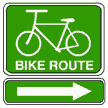
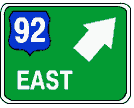

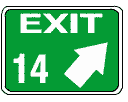
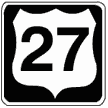
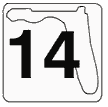
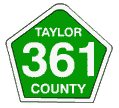
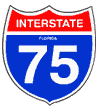
Blue Service Signs
Blue and white signs direct you to services, such as gas, food, motels and hospitals. Brown and white signs point out scenic areas and parks.




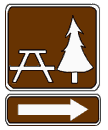

Rectangle: regulatory or information
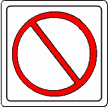 | These signs tell you the law, so you must follow their instructions. Remember that a red circle with a slash means NO. The sign shows what is not allowed. | 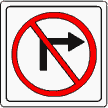 | You must not make a right turn at this intersection. |
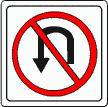 | You cannot make a complete turn to go in the opposite direction where this sign is displayed. No U-turn. |  | 50 miles per hour is the top speed you can travel in this area. |
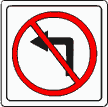 | You must not make a left turn at this intersection. |  | You are going the wrong way on an expressway exit ramp. Do not drive past this sign. Turn around immediately. |
 | A divided highway is ahead. Stay on the right side of the divider. | You may travel only in the direction of the arrow. | |
 | Parking only for vehicles displaying an official permit and transporting a handicapped person. | You cannot go straight ahead. You must turn either to the right or left. | |
 | This sign lists the maximum recommended safe speed for an entrance or exit on an expressway. Slow down to whatever speed is shown. |  | The center lane is shared for left turns in both directions of travel. |
 | You may not turn right or left during the red light. You must wait for the signal to turn green. |  | You must not pass any other vehicles going in the same direction as you are while you are in the area. |
 | A diamond-shaped marking in a traffic lane or a diamond symbol on a traffic sign shows that a lane is reserved for certain purposes or certain vehicles. The lanes are usually reserved for buses or carpool vehicles during rush hour traffic. The type of restriction and hours will be shown on the sign. |  | When you have passed this sign, you are permitted to pass other vehicles with care. |
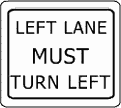 | Traffic in the left lane must turn left at the intersection ahead. |  | Stopping permitted only in emergencies. |
 | You are approaching an area where a speed zone has been established. | ||
| diamond: warning | crossbuck: railroad crossing | pentagon: school sign | |||
 | Narrow bridge. These signs warn you of special conditions or dangers ahead. Words or symbols will show why you need to use caution. |  |
 | This five-sided sign means you are near a school. Watch for children. | |
 | As you approach this sign, slow down and watch for children crossing the road. Stop if necessary. Obey signals from any crossing guards. | ||||
| circle: railroad warning | rectangle: regulatory or informational | warning signs | |||
 | Slow down and be ready to stop. You are nearing a railroad crossing. |   | Vertical signs give instructions or tell you the law. Horizontal signs give direction or information. |
Here are some common warning signs. These signs give you advance notice of possible hazards ahead. Drive with caution. | |
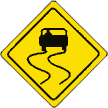 1. SLIPPERY WHEN WET. 1. SLIPPERY WHEN WET.In wet weather, drive slowly. Do not speed up or brake quickly. Make sharp turns at a very slow speed. |
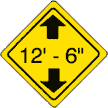 10. LOW CLEARANCE. 10. LOW CLEARANCE.Do not enter if your vehicle is taller than the height listed on the sign. |
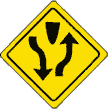 2. DIVIDED HIGHWAY AHEAD. 2. DIVIDED HIGHWAY AHEAD.The highway ahead is divided into two one-way roadways. Keep to the right. |
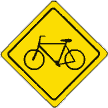 11. BICYCLE CROSSING. 11. BICYCLE CROSSING.Warns you in advance that a bikeway crosses the road ahead. |
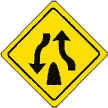 3. DIVIDED HIGHWAY ENDS. 3. DIVIDED HIGHWAY ENDS.The divided highway on which you are traveling ends 350 to 500 feet ahead. You will then be on a roadway with two-way traffic. Keep to the right. |
 12. MERGING TRAFFIC. 12. MERGING TRAFFIC.You are coming to a point where another traffic lane joins the one you are on. Watch for other traffic and be ready to yield the right-of-way when necessary. |
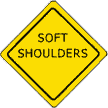 4. SOFT SHOULDER. 4. SOFT SHOULDER.The dirt on the side of the road is soft. Don't leave the pavement except in an emergency. |
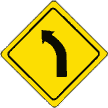 13. LEFT CURVE. 13. LEFT CURVE.Slow your speed and keep well to the right. The road will curve to the left. |
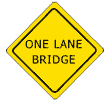 5. ONE LANE BRIDGE. 5. ONE LANE BRIDGE.The bridge is wide enough for only one vehicle at a time. Make sure the bridge is clear of oncoming traffic before you cross. |
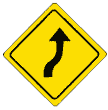 14. DOUBLE CURVE. 14. DOUBLE CURVE.The road will curve to the right, then to the left. Reduce your speed, keep to the right, and do not pass. |
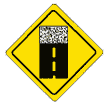 6. PAVEMENT ENDS. 6. PAVEMENT ENDS.The road surface ahead changes from a hard-surfaced pavement to a low-type surface or earth road. |
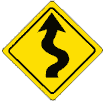 15. WINDING ROAD. 15. WINDING ROAD.There are several curves ahead. Drive slowly and carefully. |
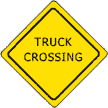 7. TRUCK CROSSING. 7. TRUCK CROSSING.Watch for trucks entering or crossing the highway. |
 16. CROSSROAD. 16. CROSSROAD.A road crosses the main highway ahead. Look to the left and right for other traffic. |
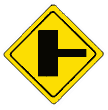 8. SIDE ROAD. 8. SIDE ROAD.Another road enters the highway from the direction shown. Watch for traffic from that direction. |
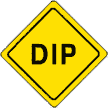 17. DIP. 17. DIP.There is a low place in the road. Go slowly and be ready to stop if the dip is filled with water. |
 9. NARROW BRIDGE. 9. NARROW BRIDGE.The bridge is wide enough to accommodate two lanes of traffic, but with very little clearance. |
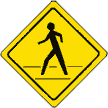 18. PEDESTRIAN CROSSING. 18. PEDESTRIAN CROSSING.Watch for people crossing the street. Slow down or stop if necessary. |
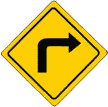 19. RIGHT TURN. 19. RIGHT TURN.The road will make a sharp turn to the right. Reduce your speed, keep to the right, and do not pass other vehicles. |
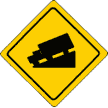 23. HILL/DOWNGRADE. 23. HILL/DOWNGRADE.Slow down and be ready to shift to a lower gear to control speed and save brakes. |
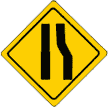 20. REDUCTION OF LANES. 20. REDUCTION OF LANES.There will be fewer lanes ahead. Traffic must merge left. Drivers in the left lane should allow others to merge smoothly. Right lane ends. |
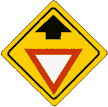 24. YIELD AHEAD. 24. YIELD AHEAD.Warning of yield sign ahead. Slow down and be prepared to stop at the yield sign or adjust your speed to traffic. |
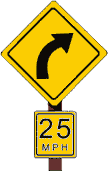 21. ADVISORY SPEED. 21. ADVISORY SPEED.The highest safe speed you should travel around the curve is the speed listed on the sign. Advisory speed signs may be used with any diamond-shaped warning sign. |
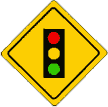 25. TRAFFIC SIGNAL AHEAD. 25. TRAFFIC SIGNAL AHEAD.This sign warns of traffic signals at the intersection ahead. Slow down; poor visibility is likely. |
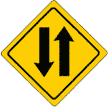 22. TWO-WAY TRAFFIC AHEAD. 22. TWO-WAY TRAFFIC AHEAD.The one-way street or roadway ahead ends. You will then be facing oncoming traffic. |
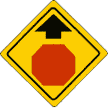 26. STOP SIGN AHEAD. 26. STOP SIGN AHEAD.When you come to this sign, slow down and be ready to stop at the stop sign ahead. |
Construction and maintenance traffic control signs
Various traffic control devices are used in road construction and maintenance work areas to direct drivers and pedestrians safely through the work site and to provide for the safety of highway workers.
The most commonly used devices are signs, cones, drums, barricades, and flashing arrow panels. Orange is the basic color for these devices. You may also see a flagperson directing traffic.
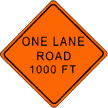


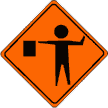
Flagperson Ahead
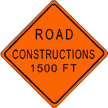
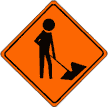
Workers Ahead
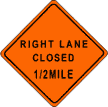
Channeling Devices
Barricades, vertical panels, drums, and cones are the most commonly used devices to alert drivers of unusual or potentially dangerous conditions in highway and street work zones. These devices are used to guide the drivers safely through the work area. At night they may be equipped with warning lights. When a Road Closed sign is displayed, do not drive on this road. Look for a detour or another route.
Flashing arrow panels are used both during the day and at night to give advance warning and directional information to drivers where it is necessary to move to the right or to the left into another lane.
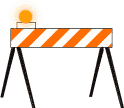
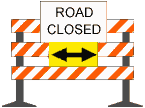





Stripes on barricades and panel devices slope downward in the direction traffic must turn when directed to detour or move from one lane to another.
Yellow Center Line Markers
Broken
A broken yellow line shows that you may pass on the left when the way ahead is clear. Remember that you are facing oncoming traffic, so overtaking and passing should be done with care.

Solid & Broken
A solid yellow line to the right of a broken yellow line means passing or crossing is prohibited in that lane, except when turning left.

Double Yellow
Double solid yellow lines show that passing is not allowed in either direction. You may not cross the lines unless you are making a left turn.

8. 4. School buses including laws on passing while stopped
On average, eight school-age pedestrians are killed by school buses (or vehicles used as school buses) each year, and four are killed by other vehicles involved in school bus related-crashes.
More school-age pedestrians have been killed from 7 a.m. to 8 a.m. and from 3 p.m. to 4 p.m. than any other times of day.
From 2007 to 2016, 1,147 people have died in school transportation-related crashes - an average of 128 fatalities per year. Most of the people who lost their lives in those crashes (70 percent) were occupants of other vehicles involved. Non-occupants (pedestrians, bicyclists, etc.) accounted for 20 percent of the deaths, and school bus occupants accounted for 9 percent.
From 2007 to 2016, 98 school-age pedestrians (under 19 years old) have died in school transportation-related crashes. Over two-thirds ( 60 percent) were killed by school buses, two percent by vehicles functioning as school buses, and 38 percent by other vehicles involved in the crashes. Thirty-three percent of all school-age pedestrians killed in school transportation-related crashes were between the ages of 5 and 7. 3
Who must stop for a school bus which has stopped on the roadway to pick up or discharge passengers? The next three diagrams will give an explanation of an event. You must decide who can go and who must stop. The correct answer is given at the end of the questions. An explanation of the law will follow.
School Bus
Diagram 1
This is a five-lane highway. Two lanes are moving in one direction and two lanes are moving in the other direction. The center lane is a left turn lane. The school bus is stopped with the red lights flashing and the stop arm extended.
Answer: Answer the questions above to see the correct answer.Correct! By law all vehicles must stop. The highway is not divided.Incorrect! By law all vehicles must stop. The highway is not divided.
School Bus
Diagram 2
This is a four-lane divided highway. Two lanes are moving in one direction and two lanes are moving in the other direction. The median spans 10 feet. The school bus is stopped with the red lights flashing and the stop arm extended.
Answer: Answer the questions above to see the correct answer.Correct! By law the brown and red car must stop. The green car and the blue car are not required to stop due to the highway being divided by an unpaved median of more than five feet.Incorrect! By law the brown and red car must stop. The green car and the blue car are not required to stop due to the highway being divided by an unpaved median of more than five feet.
School Bus Diagram 3
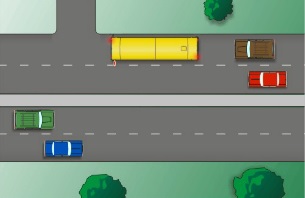
This is a four-lane divided highway. Two lanes are moving in one direction and two lanes are moving in the other direction. The median consists of a raised concrete barrier. The school bus is stopped with the red lights flashing and the stop arm extended.
Answer: Answer the questions above to see the correct answer.Correct! By law only the brown and red vehicles must stop. The blue and green vehicles are not required to stop because the median is a raised concrete barrier.Incorrect! By law only the brown and red vehicles must stop. The blue and green vehicles are not required to stop because the median is a raised concrete barrier.
Penalties for Passing a Stopped School Bus
- Four points on the offender's driving record
- Required mandatory hearing in front of a judge
- Fines: $165 for the offense of failing to stop for a school bus, and $265 for the offense of passing a school bus on the side that children enter and exit when the school bus displays a stop signal
- For a second conviction within five years, license will be suspended for a period of not less than 90 days or more than six months
- Additional civil penalties imposed upon conviction
- Completion of Basic Driver Improvement course required
Right on Red
A simple maneuver, right on red, if not executed properly, can be expensive in fines paid or cause a serious crash. F. S. S. 322.27(3)(b)
- Proper (right-hand) lane: F.S.316.151(1)(a) "...the approach for a right turn... shall be made as close as practicable to the right-hand curb or edge of the roadway."
- Proper signal when required: F.S.316.155(2) "A signal of intention to turn right...must be given continuously during not less than the last 100 feet by the vehicle approaching."
- Come to a complete stop: F.S.316.075(3)(a) "Vehicular traffic facing a steady red signal shall stop before entering the crosswalk...or intersection."
- No sign forbidding turn: F.S.316.075(3)(a)(1) "...except that municipal and county authorities may prohibit as such against a steady red signal."
- Yield right of way: F.S.316.075(3)(a)(1) "...shall yield the right of way to pedestrians and other traffic proceeding as directed by the signal."
- To proper lane: 316.151(1)(a) "...a right turn shall be made as close as is practicable to the right hand curb or edge of roadway."
8. 5. Proper response to emergency vehicles
LET THEM THROUGH
Not every emergency medical response requires lights and sirens, but the next time you encounter such a situation, yield immediately so that the emergency personnel can reach the person who is waiting for help to arrive. Remember that it's important to let them through. The next time it could be you.
In an emergency, minutes can mean the difference between life and death, and critical seconds can be lost if drivers don't make way for emergency vehicles. Take sirens seriously - make way for an ambulance, fire truck or police vehicle. Someday you may be the one calling for help, or the life on the line might be a friend.
You can do some simple things to help emergency personnel reach a person in need. Use the letters S-I-R-E-N to remember the right way to yield to an emergency vehicle.
- Stay Alert
Drive defensively, keep the noise level down in your vehicle, and look for more than one emergency vehicle approaching when you hear a siren. - Investigate
Check your rearview mirror, scan in front and on both sides of your vehicle, try to estimate the speed of the emergency vehicle, and plan your next move. - React
React quickly, but calmly, and scan in all directions before pulling over to the closest edge of the road. Pull as far off the highway as you can, as safely as possible. Stop and remain stopped until the emergency vehicles pass. Don't slam on the brakes or pull over suddenly. Gradually brake to avoid losing control in loose gravel on the shoulder. Always use a turn signal when exiting the roadway. - Enter
Before reentering the roadway, make a visual sweep in all directions. Turn on your turn signal, and gradually merge back into traffic. - Never Block or Follow
Don't stop at a place that doesn't have enough room to pull over safely and never follow or try to outrun an emergency vehicle.
Be alert for pedestrians who may be in the crosswalk or at the edge of the roadway. They might be looking for the emergency vehicle as well and not be aware of your efforts to yield properly.
Always use your signal so that other drivers know how you intend to exit the road and look for others that may have to cross lanes of traffic to yield. Pull as far off the highway as possible, as safely as possible and gradually brake to avoid losing control in loose gravel on the shoulder.
Move Over Act
The safety of our emergency workers and law enforcement officers is always of paramount importance. They put their lives on the line every day to ensure that our roadways are as safe as they can be. Too many of these individuals have been severely injured or killed while executing their jobs. To help combat this problem, the Florida legislature passed the "Move Over Act" which states that when you encounter an emergency vehicle parked on the side of the road, you must:
- Vacate the lane closest to the emergency vehicle when on an interstate highway or a highway with two or more lanes traveling in the same direction as the emergency vehicle, unless directed otherwise by a police officer.
- Slow to a speed that is 20 mph less than the posted speed limit when the posted speed limit is at least 25 mph; or reduce your speed to five mph when the posted speed limit is less than 20 mph when driving on a two-lane road, unless otherwise directed by a police officer.
On July 1, 2014, the "Move Over Act" was amended to include not only emergency vehicles (including law enforcement, fire/rescue and tow trucks) but also sanitation (garbage/recycling) and utility vehicles (electric, water, cable, gas).
A violation of this law is a noncriminal traffic infraction and is considered a moving violation.
8. 6. Required vehicle safety equipment
BRAKES:
Your car must have two braking systems. Each must be able to stop the car alone. The parking brake or emergency brake should be strong enough to hold the car on any hill. This is a manual brake and operated by a separate pedal or a pull handle. Please refer to your owner's manual to determine which kind of emergency brake your car is equipped with. It must be set after parking and be released before moving the car. It may be used to help stop the car if the other brakes fail. If you do need to stop the car, work the parking brake gradually to prevent locking up the wheels and sending the car out of control. In addition to working the parking brake, release your foot from the accelerator and downshift to slow the car down.
The other braking system is a hydraulic fluid braking system, sometimes called power-assisted brakes. Applying the foot pedal located next to the accelerator (gas pedal) activates the system. Maximum pressure on this type of braking system can cause brake lock-up and cause the vehicle to start skidding, resulting in loss of control. To prevent this from happening, you must pump the brakes while maintaining control of the car. You must apply enough pressure to get maximum braking without skidding.
Some vehicles have what is called ABS or anti-locking braking system, a system which will not allow the brakes to lock up. In an emergency situation, you must put your foot on the brake and not release it. If you do this with ABS brakes, you will feel a vibration coming from the brakes that means the brakes are doing their job. They are basically pumping the brakes for you. ABS is very good on wet roadways or roadways with less than normal or little friction. The hydraulic system using brake fluid needs to be checked periodically. Once again, check your owner's manual so you know which braking system your vehicle uses.
You are required to have your brakes in such a condition that at the speed indicated, you are able to stop within the yellow zone. However, it is much more beneficial to have your brakes in such a condition that you are able to stop in the green "safety" zone.
LIGHTS:
Your car must have the following lights:
- Bright (high-beam) headlights which show objects 450 feet ahead.
- Dimmed (low-beam) headlights which show objects 150 feet ahead.
- Two red taillights mounted on the rear, visible from 1,000 feet.
- A white light that keeps the license plate visible from 50 feet (the plate must be kept clean).
- Two red stoplights, seen from 300 feet in the daytime, that must come on when the foot brake is pressed.
- Two white lights that indicate when you are backing up.
- Two amber lights that serve as your turn signals which allow other motorists to know when and where you are turning.
All vehicles, including animal-drawn vehicles, must have at least one white light visible from a distance of not less than 1,000 feet to the front. They must also have two red lights visible from a distance of not less than 1,000 feet to the rear, or one red light to the rear visible at 1,000 feet and two red reflectors visible from all distances from 600 to 1,000 feet.
HORN:
Your vehicle must have a horn that can be heard from a distance of 200 feet.
WINDSHIELD WIPERS:
Your vehicle must have windshield wipers in good working order for cleaning rain, snow, or other moisture from the windshield.
WINDSHIELD:
The windshield on your vehicle must be safety glass and may not be covered or treated with any material that has the effect of making the windshield reflective or in any way non-transparent. It must be free of any stickers not required by law.
SIDE WINDOWS:
The side windows on your vehicle may not be composed of, covered by, or treated with any material which has a highly reflective or mirrored appearance and reflects more than 35% of the light.
REAR WINDOW:
When the rear window is composed of, covered by, or treated with any material which makes the window non-transparent, the vehicle must be equipped with side mirrors on both sides.
DIRECTIONAL SIGNALS:
You must have electrical turn signals if your vehicle measures more than 24 inches from the center of the top of the steering post to the left outside limit of the body, or when the distance from the steering post to the rear of the body or load is greater than 14 feet.
TIRES:
Your tires should have visible tread of at least 3/32 of an inch across the base with no worn spots showing the ply. Smooth tires on wet roads contribute to serious crashes.
MIRRORS:
Your car must have at least one rearview mirror which gives a view of the highway at least 200 feet to the rear.
EXHAUST SYSTEMS:
Your vehicle must have a good, working exhaust system in operation at all times. This system must include a muffler, a manifold pipe, and a tailpipe that prevents excessive or unusual noise. There is a maximum level of noise (measured in decibels) that is legal in Florida. The exhaust system must prevent the escape of excessive fumes or smoke. Your vehicle must have proper equipment to prevent air pollution.4
1 NHTSA Traffic Safety Facts 2016 - Speeding https://crashstats.nhtsa.dot.gov/Api/Public/ViewPublication/812480
2 The Economic and Societal Impact Of Motor Vehicle Crashes, 2010 http://www-nrd.nhtsa.dot.gov/Pubs/812013.pdf
3 NHTSA Traffic Safety Facts 2016 - School Transportation-Related Crashes https://crashstats.nhtsa.dot.gov/Api/Public/ViewPublication/812476f
3 Florida Drivers Handbook
9. Conclusion and Final Exam
Congratulations! You have completed all of the chapters in the Basic Driver Improvement course. To receive your certificate, you must pass a 40-question final exam. You must answer at least 80% (32) of the questions correctly to receive a course completion certificate.